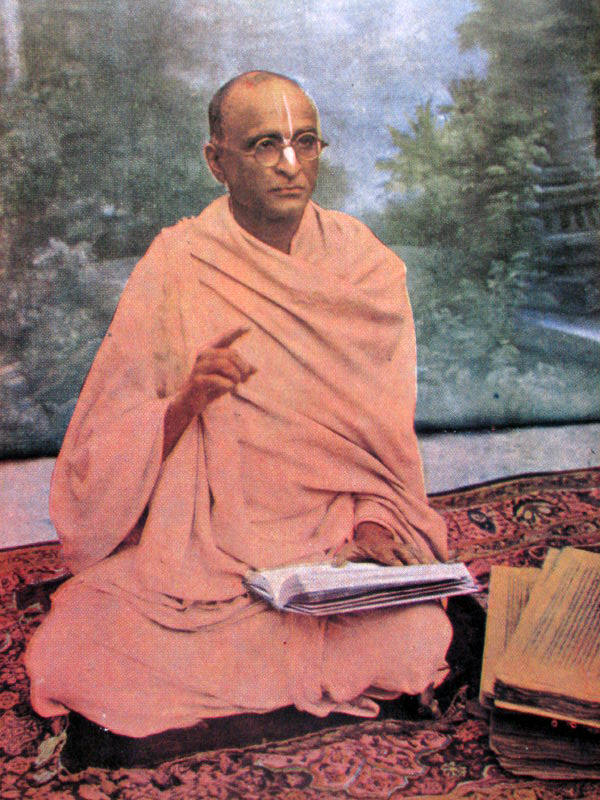
sri-varshabhanavi-devi-dayitaya kripabdhaye krishna-sambandha-vijnana-dayine prabhave namah
I offer my respectful obeisances to Sri Varshabhanavi-devi-dayita dasa [another name of Srila Bhaktisiddhanta Sarasvati], who is favored by Srimati Radharani and who is the ocean of transcendental mercy and the deliverer of the science of Krishna.
Childhood 1874-1892
Srila Bhaktisiddhanta Saraswati Thakur appeared in this world on the 6th of February, 1874 in Purusottama Kshetra (Jagannath Puri) in the state of Orissa. He was the fourth son of Kedaranath Datta – later known as Srila Bhaktivinoda Thakur – and Srimati Bhagavati Devi. Bhaktivinoda Thakur was at this time the Magistrate at Puri, and one of his duties was to oversee the smooth running of the Jagannath Temple.
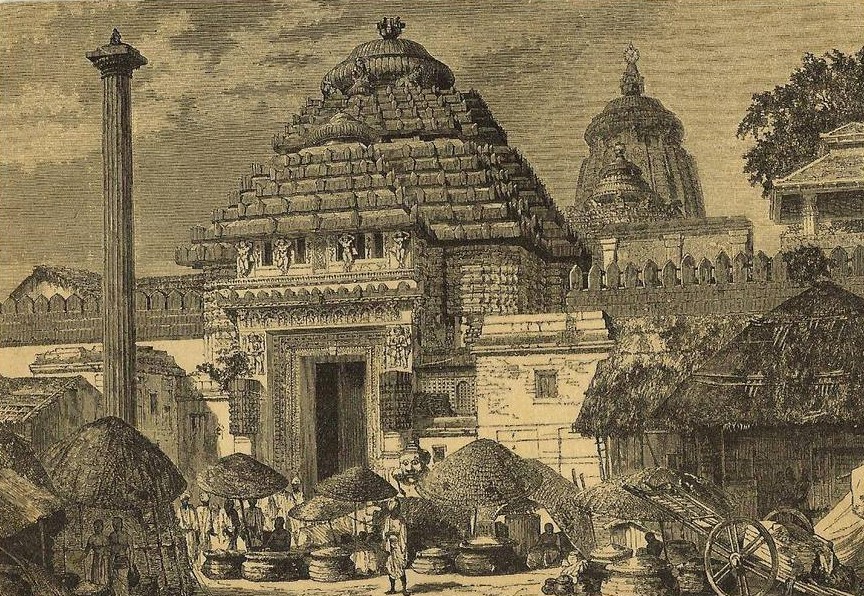
The Jagannath Temple at Puri
The Thakur visited the Temple daily. At this time he was immersing himself in the study of Sankskrit and familiarising himself with many important Vaisnava literatures. Taking on the huge task of regenerating the pure movement of Lord Chaitanya, the Thakur was feeling somewhat overwhelmed. He had prayed to Lord Jagannath “to send a Ray of Vishnu” – a shaktavesh avatar or empowered living entity – a qualified assistant to help him in his mission to preach the message of Sri Chaitanya Mahaprabhu all over the world.
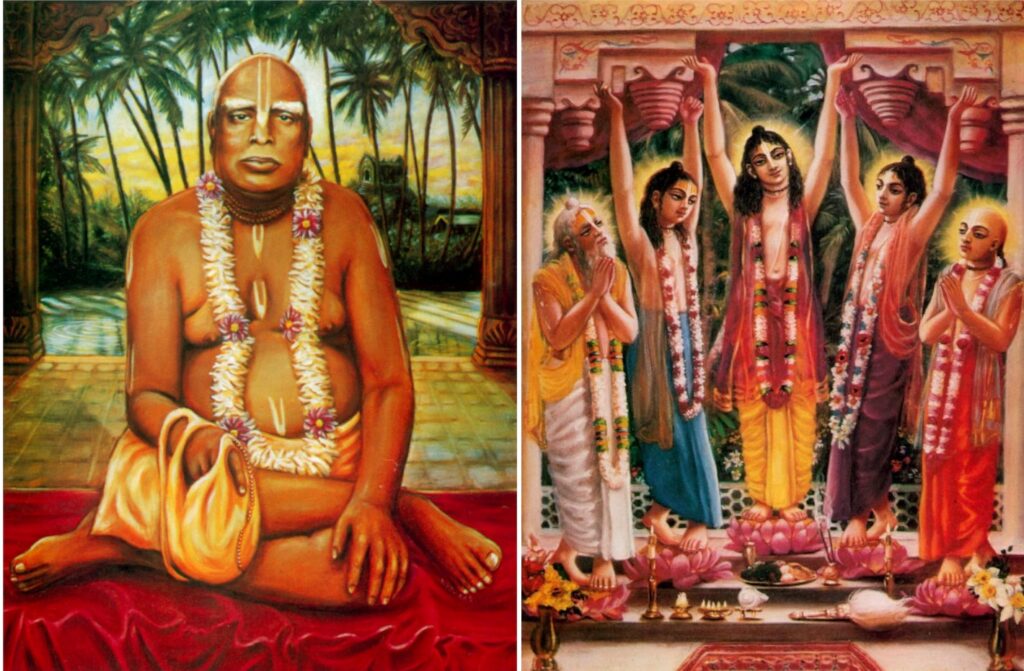
One night, the Deity of Jagannath personally spoke to the Thakur in a dream, saying:
I didn’t bring you to Puri to execute legal matters, but to establish Vaisnava siddhanta.
Srila Bhaktivinoda Thakur, who was at this time about forty-two, replied:
Your teachings have been significantly depreciated, and I lack the power to restore them. Much of my life has passed and I am otherwise engaged, so please send somebody from Your personal staff so that I can start this movement.
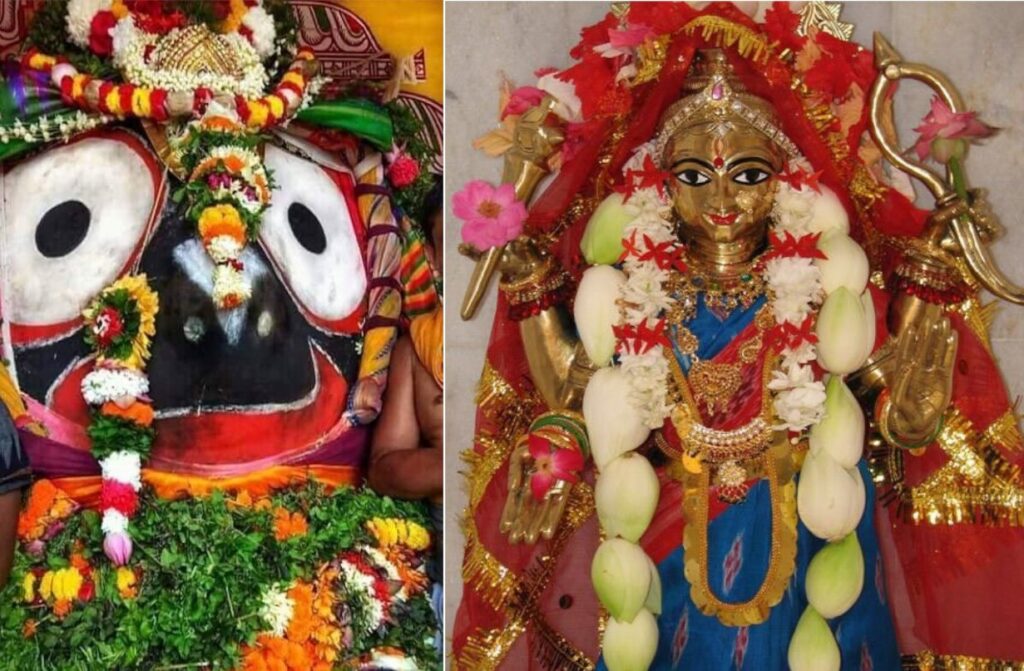
Lord Jagannath and Bimala Devi
Jagannath then requested Srila Bhaktivinoda Thakur to pray for an assistant to the Deity of the Goddess Bimala Devi. Bimala is a name of Mayadevi. As an expansion of Goddess Laksmi, she is considered to be the consort and transcendental potency of Lord Jagannath. The Bimala Devi Temple is located within the Jagannath Temple complex. No separate food offerings are cooked for Goddess Bimala, who eats only the remnants of Lord Jagannath’s vegetarian prasadam. When his wife gave birth to a new child, the Thakur linked the event to the divinatory dream and named his son Bimala Prasad. Bimala Prasad means “the mercy of the transcendental potency of Lord Jagannath, Srimati Bimala Devi.”
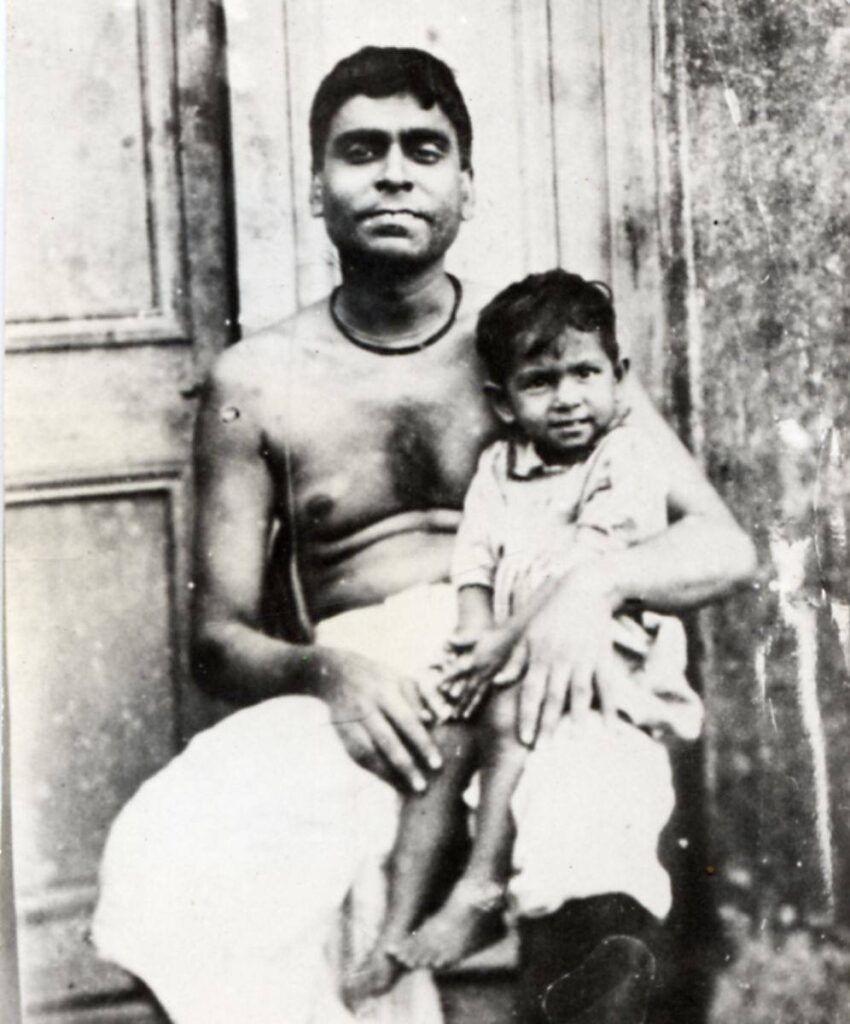
Bimala Prasad with Bhaktivinoda Thakur
The child was born near the Jagannath-vallabha gardens, in a large house adjacent the Narayana Chata Matha. He was born with his umbilical cord wrapped around his neck like a brahman’s thread. An astrologer commented at his birth:
I have done many horoscopes in my life, but I have never before seen such a horoscope filled with all the signs of a great personality. This child will become world famous as a brilliant teacher of life’s ultimate goal.
When the child was six months old, Lord Jagannath’s Rathayatra Festival was in procession, and the cart stopped in front of Srila Bhaktivinoda Thakur’s house and would not budge for three days. Following the instructions of Srila Bhaktivinoda Thakur, Bhagavati Devi brought the child before the cart and an offered garland fell from the neck of the Lord, encircling the boy. The crowd was jubilant witnessing Lord Jagannatha’s blessing of the child. This was taken as a sign of special favour by all present.
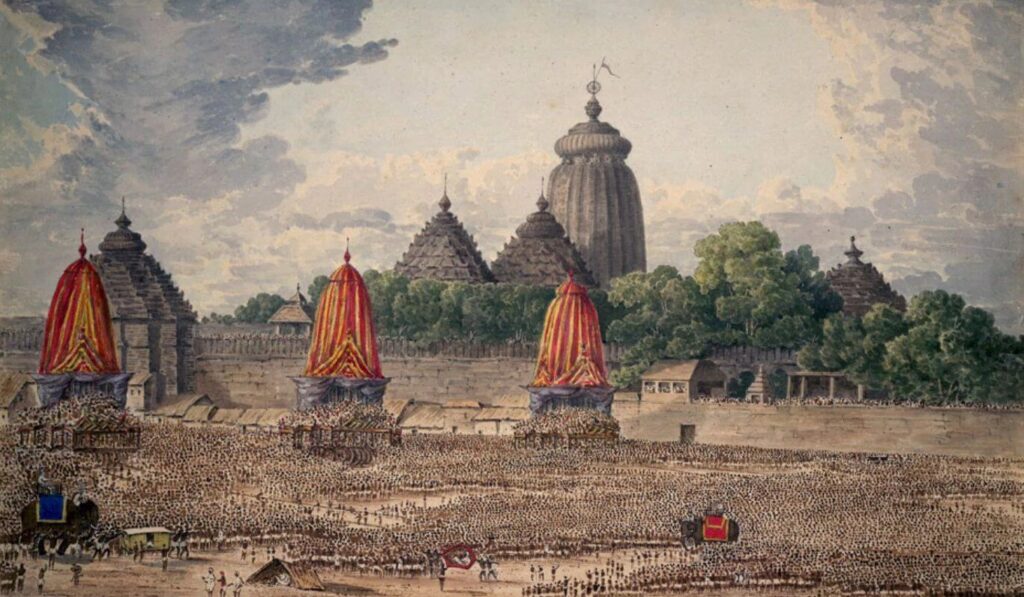
While an infant, the boy’s vocational inclination was tested. He was given the choice of gold coins or the Srimad Bhagavatam. The child immediately embraced the Srimad Bhagavatam, indicating his future as a preacher. From the very beginning of his appearance, Srila Bhaktisiddhanta Sarasvati Thakur exhibited all the signs of an exalted, eternal associate of the Lord, who had descended in answer to Srila Bhaktivinoda’s prayer for a “ray of Vishnu” to help him spread Lord Chaitanya’s Movement.
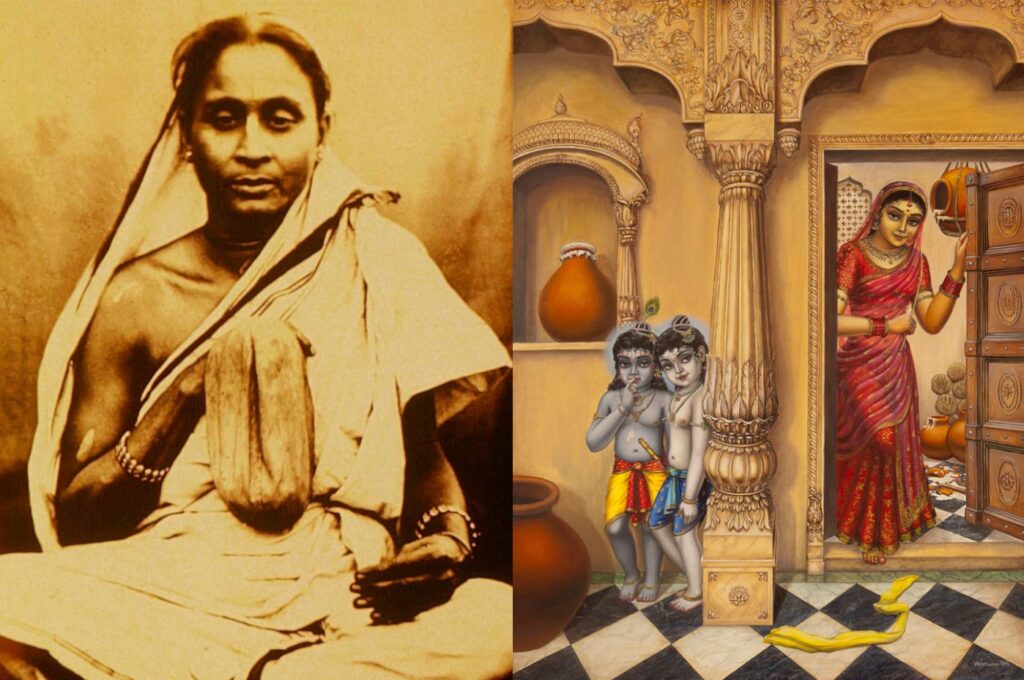
Srimati Bhagavati Devi and Krishna and Balarama hiding from Mother Yasoda
Sri Bimala Prasada lived in Jagannatha Puri for ten months. Then he travelled to Bengal and he grew up in his early years in Ranaghata in the District of Nadia, hearing about Krishna from his mother. When he was a small boy, perhaps two or three years old, Srila Bhaktivinoda Thakur brought some ripe mangoes from the market. Bimala Prasad took one to eat, saying, “This is mine.” Srila Bhaktivinoda Thakur got up and said in a grave voice:
What is this? New fruit has come into the house. It has not been offered to Giridhari [Krishna] and you have taken it first? Remember, new fruit is to be given first to the Lord. Without giving the first share to the Lord, nothing is to be taken.
The child was very repentant and exclaimed:
Oh, what evil thoughts I have had! Throughout my whole life I shall not eat these again. This is the right punishment for one ruled by greed.
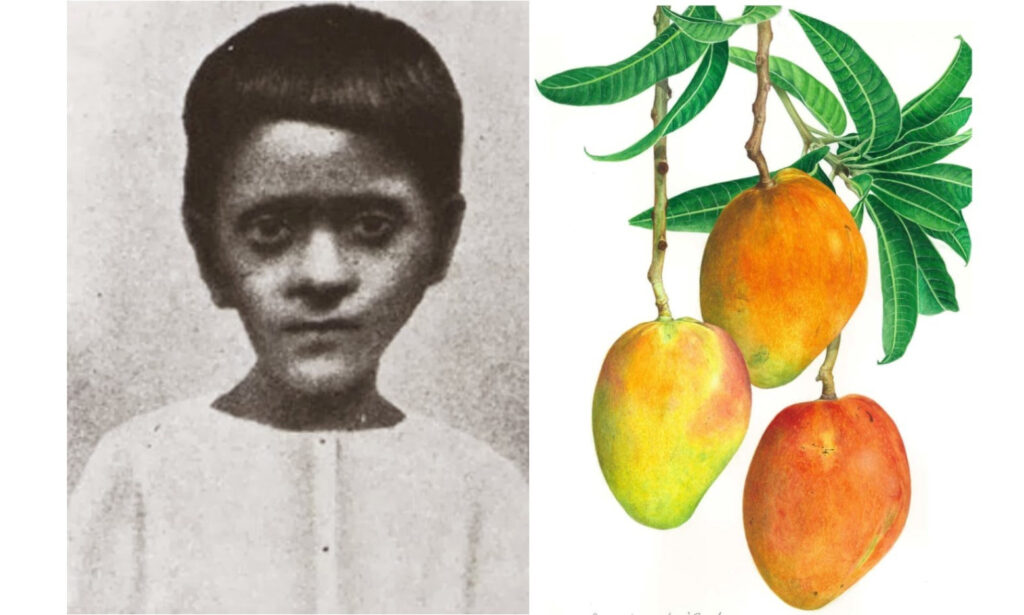
He made the promise and observed it throughout his whole life. Srila Bhaktivedanta Swami Prabhupad comments on this incident:
Whenever we offered him mango he said, “No, I am an offender. I cannot take mango.” He was thinking that “I have offended [Krishna] in my childhood by taking the mango of the Deity.” So this is the characteristic of the acharya. They teach by their life’s action – one should be so much determined. A child took the mango, there is no offense, but he took that vow.
In 1881, when Bimala Prasad was seven years old, Srila Bhaktivinoda Thakur was constructing a house in Calcutta at Ramabagana, which he called Bhakti Bhavan. During the construction, a Deity of Lord Kurma was unearthed. Srila Bhaktivinoda Thakur instructed his son to begin worship of that Deity. From the very beginning, the boy used to hear the preaching of his father with rapt attention. Srila Bhaktivinoda Thakur, as well as his audiences, were amazed to see how a small boy could hear the topics of Krishna bhakti with such total absorption.
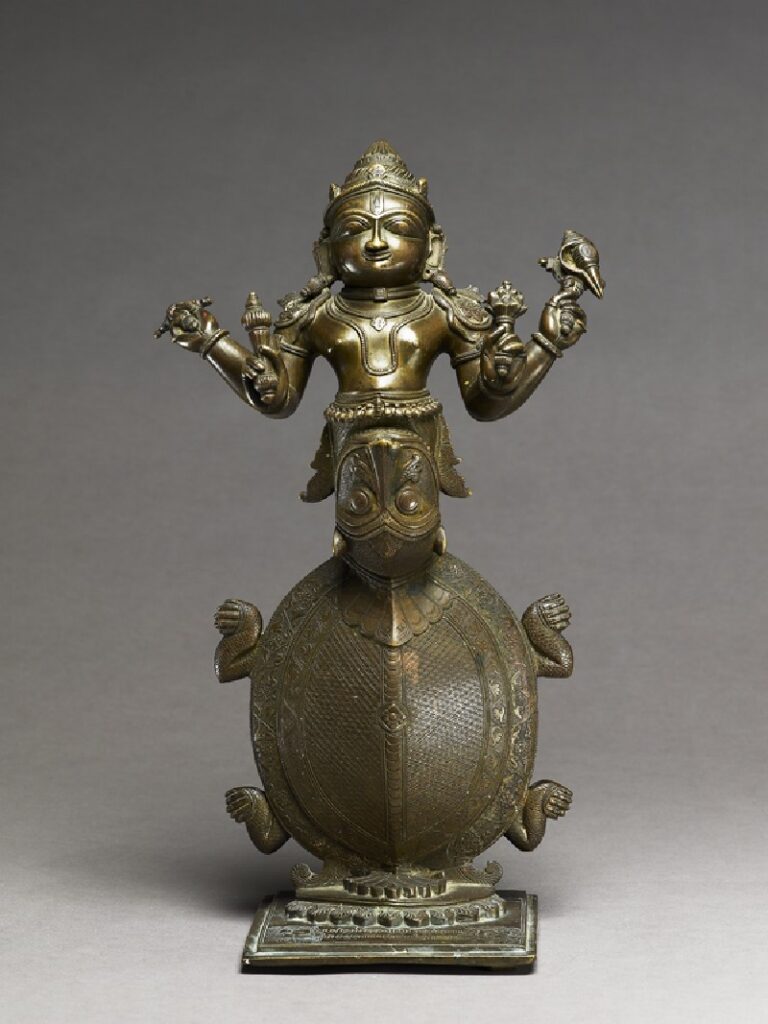
A Lord Kurma Deity
By the age of seven he had memorised the entire Bhagavad-gita, and could explain the meaning of every verse. Later, around 1885, he was trained in publishing and proof-reading at Srila Bhaktivinoda Thakur’s printing press where the Thakur’s well-known spiritual journal, the Sajjana-Tosani, was produced. At the age of eleven, Bimala Prasad toured the various places of Sri Chaitanya Mahaprabhu’s pastimes with his father, where he heard extensive discussions on the Holy Name. The boy had a photographic memory, and whatever he would read once he could later recall with perfect clarity. Even in his later years, he could perfectly quote entire pages of books he had read as a child.
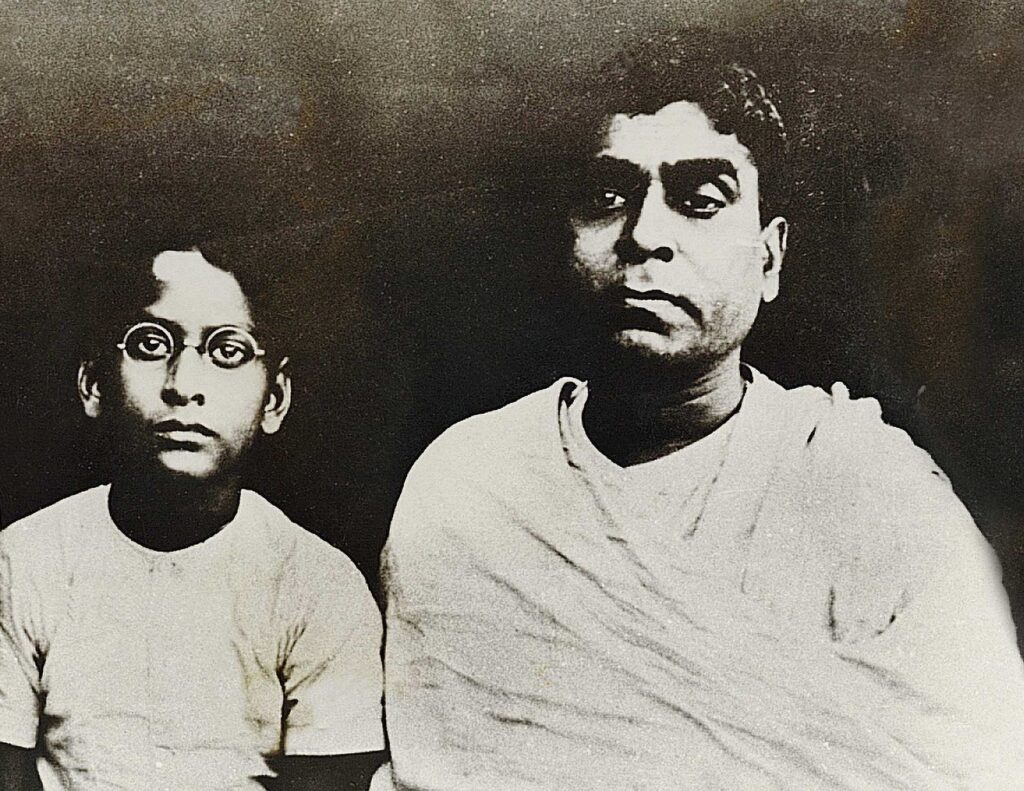
At age eleven, when Bimala Prasada was in fifth grade, he invented a new method of shorthand which he called “Bicanto.” His teachers were always amazed by his mastery of Bengali and Sanskrit, his extraordinary intelligence and memory, and his pure moral and devotional nature. At this time Srila Bhaktivinoda Thakur gave him Sri Chaitanya Siksamrta to read. Bimala Prasada also displayed extraordinary ability in mathematics and astrology. He studied astrology under the tutelage of the famous astrologer Mahesh Chandra Churamani, and impressed his teacher with his mastery of the subject and his exceptional talent. He also studied astrology with Pandit Sundar Lal. Seeing his scholarship in many different subjects, including the scriptures, his teachers named him Sri Siddhanta Sarasvati – “master of scriptural conclusions.” When Srila Sarasvati Thakur was a student in the seventh grade in Srirampur, aged thirteen, Srila Bhaktivinoda Thakur gave him Tulasi-mala chanting beads from Jagannath Puri and instructed him on the chanting of the Hare Krishna mantra as well as Sri Nrsimha mantra.
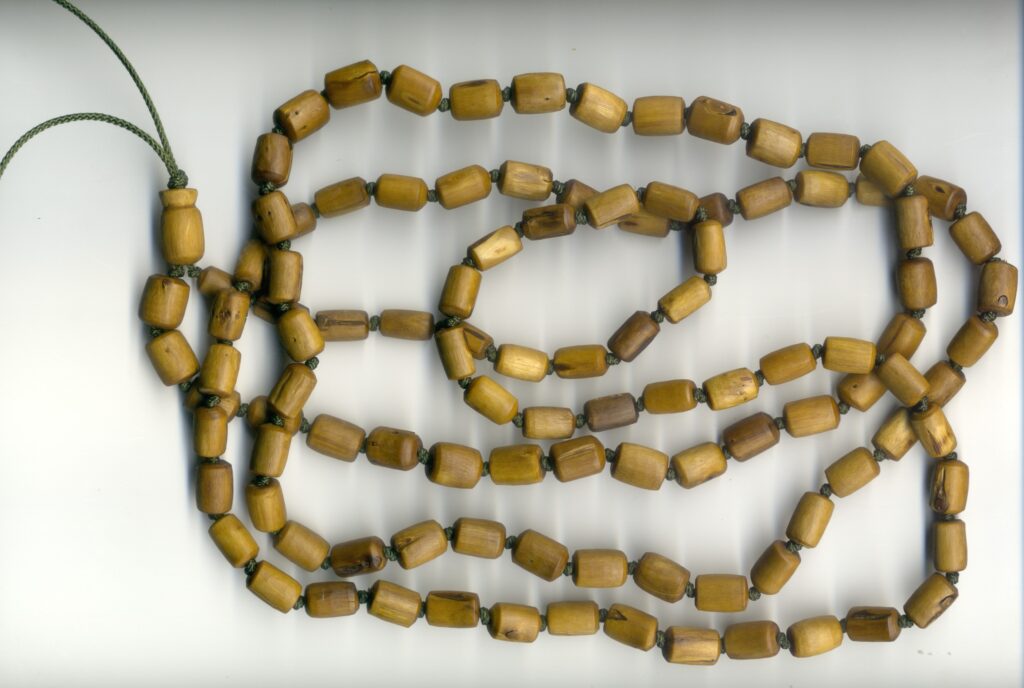
In 1885, Srila Thakur Bhaktivinoda established his Visva-Vaisnava Raj-Sabha (“Great Assembly of the Vaisnavas of the World”) in the house of Sri Ramgopal Basu on Bethune Row in Calcutta. The Thakur would speak from scriptures such as Srila Rupa Goswami’s Bhakti-rasamrta Sindhu (The Ocean of the Nectar of Devotion). Many well known personalities such as Madangopal Goswami, Nilkanta Goswami, Bipin Vihari Goswami, Radhikanath Goswami, and Shishir Kumar Ghosh attended the weekly Sunday meetings of the society and participated in discussions. Srila Sarasvati Thakur used to carry his copy of Bhakti-rasamrta Sindhu to these meetings, and listen to the discussion there with rapt attention.
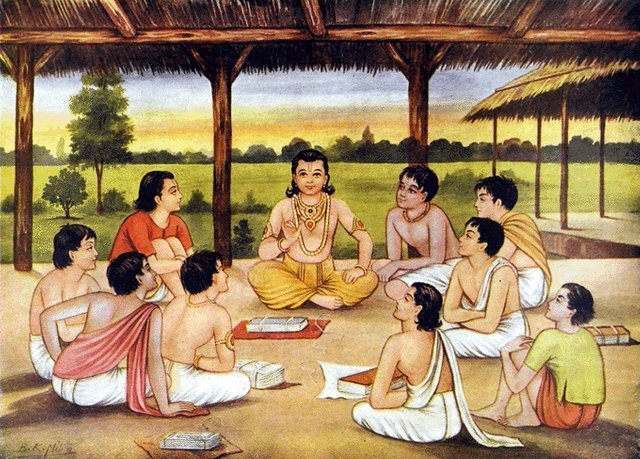
Prahlad instructs his school friends
Like the great child devotee Prahlad, Srila Sarasvati Thakur was not interested in associating with other boys of his age unless they were interested in spiritual matters. His two favourite books were Prarthana and Prema-Bhakti Chandrika by Srila Narottama Das Thakur. As a young boy, he published books on astrology such as Surya Siddhanta and Bhakti Bhavan Panjika. In the afternoons he spent hours debating about religion and philosophy with other students in Calcutta’s Beadon Square. Later, while still a teenager, he founded the August Assembly. All members of the Assembly had to take a vow of lifelong celibacy. Many educated people, both young and old, took part in the Assembly.
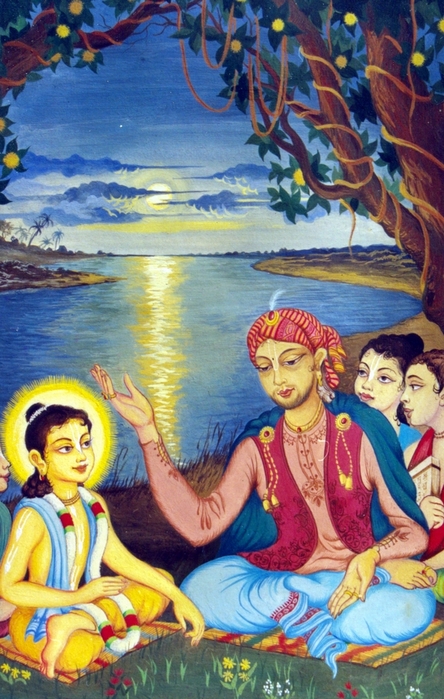
Young Nimai debates with Kesava Kasmiri
In his teens, Srila Bhaktisiddhanta Sarasvati Thakur used to debate everyone he met on all sorts of subjects, and no one who argued with him was ever able to defeat him. Just as Sri Chaitanya Mahaprabhu had defeated the great scholar Kesava Kasmiri at a young age, Bimala Prasad once, during his later college days, debated a scholar named Panchanana Sahityacharya, the disciple of Vasudeva Sastri, a very famous professor of that time on topics of astrological calculation. After some discussion the scholar had to accept defeat. In fact, on losing the debate he became so mortified that he could not check the calls of nature. After that, everyone was reluctant to debate him for fear of being defeated.
Sanskrit College and Work in Tripura: 1892-1905
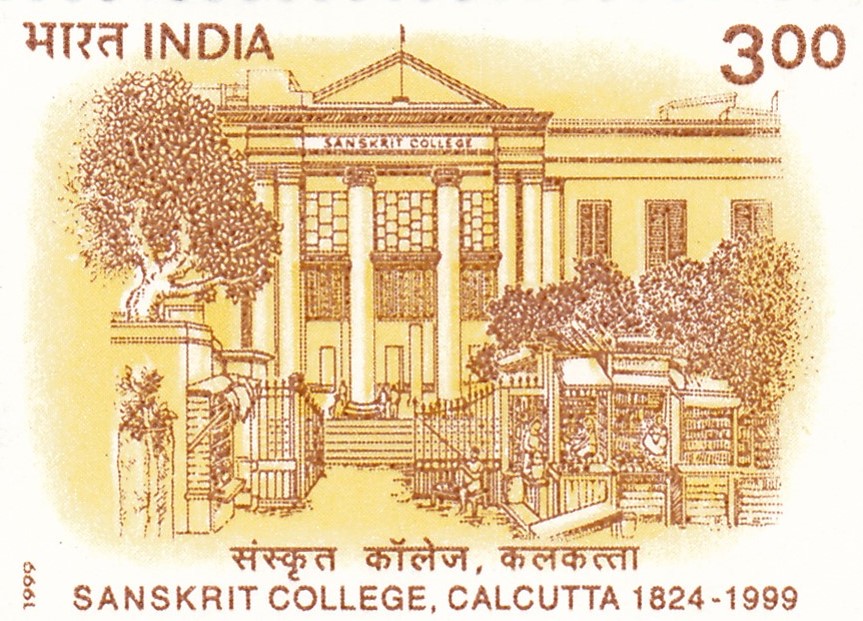
In 1892 Srila Sarasvati Thakur finished high school and enrolled in the Sanskrit College. He was more interested in reading various philosophical books in the college library than in reading his own textbooks. He studied the Vedas under Pandit Prithvidhar Sharma after college. He also studied the Siddhanta Kaumudi in a very short time. But his spiritual interests did not allow him to stay in college for very long. He wrote in his autobiography:
If I keep studying at college with great attention, then I will be under a lot of pressure to enter family life. But if I am seen as a stupid, incompetent person, then no one will try to influence me towards material progress. Thinking this, I left the Sanskrit College, and in order to live a life of devotional service, I wanted a pious occupation so I could have a modest income.
In 1897, Srila Sarasvati Thakur established the Saraswat Chatuspathi (“The Saraswat Academy”) at Bhakti Bhavan. Many prominent and educated men such as Lala Haragaurishankar, Dr. Ekendranath Ghosh, Satkari Chattopadhyaya, Shyamlal Goswami, and Saratchandra Vidyavinod came to study astronomy, astrology and mathematics there. From Saraswat Chatuspathi, Srila Sarasvati Thakur published astrological magazines such as Jyotirvid and Brhaspati,as well as quite a few ancient astronomy and astrology texts. He was well-acquainted with both the Eastern and Western branches of astrology, but naturally favoured the Vedic one. He was offered a chair in astronomy at the University of Calcutta by Sir Asutosh Mukherjee, but Siddhanta Sarasvati declined it, thinking it an impediment to his spiritual life.
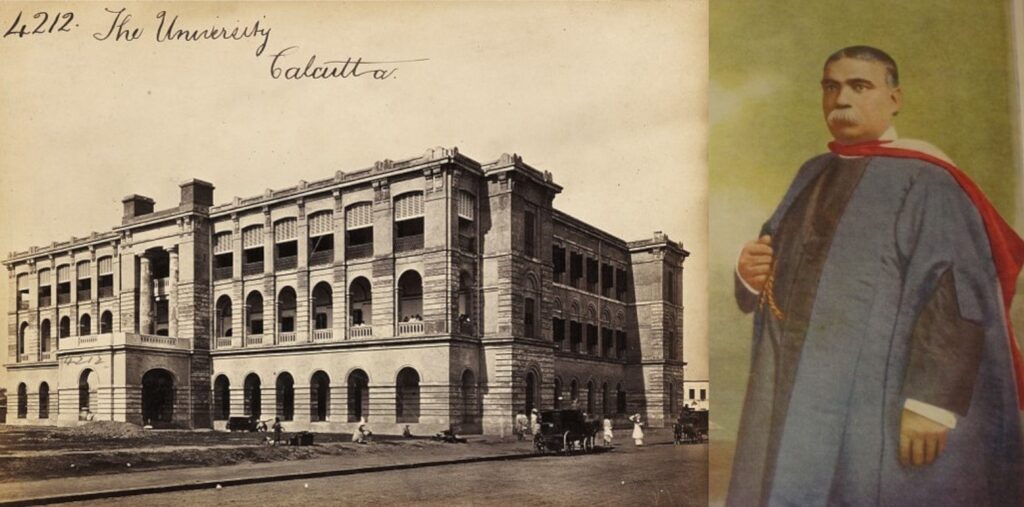
The University of Calcutta and Sir Asutosh Mukherjee
At the request of Srila Jagannath Das Babaji, he composed the Sri Navadvipa Panjika, an astrological almanac in which the months, lunar fortnights, days, lunar days, stars, etc. were all given names of Vishnu. The almanac recorded the dates of the appearance and disappearance of the Lord’s incarnations and important Vaishnava saints, and the celebration of important festivals. Later, the Chaitanya Math began publishing the Navadvip Panjika in accordance with Babaji Maharaj’s wishes. Srila Bhaktisiddhanta Sarasvati did not spend very long in his astronomical pursuits, however, and soon dedicated himself fully to the worship and distribution of the teachings of Sri Chaitanya Mahaprabhu.
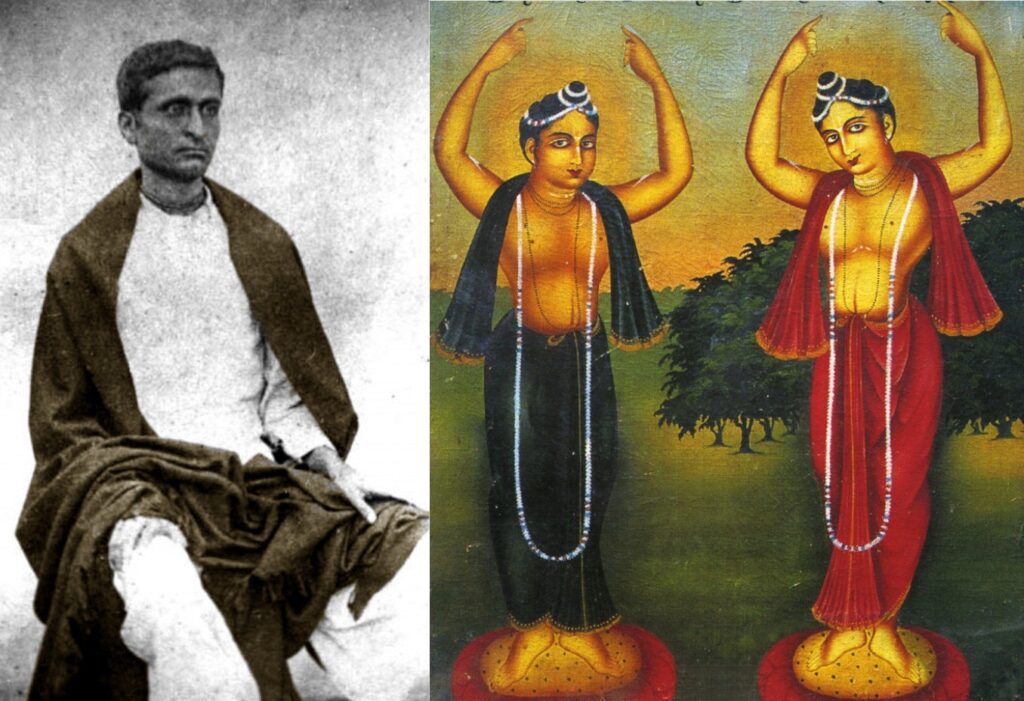
He was employed by the royal kings of Tripura from 1895 to 1905 in various services. Initially he accepted a post editing a history of their family entitled Raj Ratnakar. During this time he studied all of the principal books in the Royal Library. A year later, however, the Maharaja departed from this world. The succeeding king, Maharaja Radhakisore Manikya Bahadur entrusted Siddhanta Sarasvati with the instruction of the sons of the king in Bengali and Sanskrit. The king also requested him to put an end to various cheating activities of persons who were misappropriating royal wealth. Siddhanta Sarasvati quickly stopped this nonsense, much to the delight of the king. He assisted the royal family in different ways until 1905.
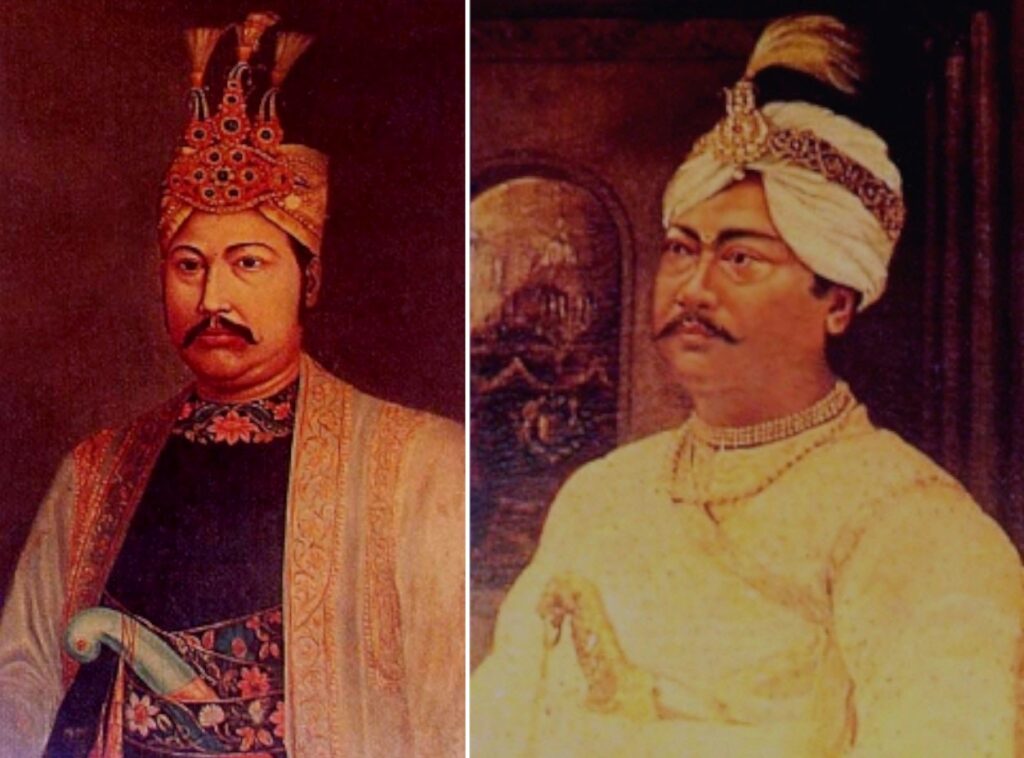
The Maharajas of Tripura: Bir Chandra Manikya and Radha Kishore Manikya Bahadur
Austerities, Bhajan and Initiation
In 1897 Srila Bhaktivinoda Thakur established his own bhajan-kutir (cottage for reclusive devotional practice), called Ananda-sukhada-kunja, on the Godruma island of Navadvip on the bank of the river Sarasvati. There, in the winter of 1898, Srila Sarasvati Thakur met with an extraordinary, exalted Vaisnava saint, Srila Gaurakisora Das Babaji, who captured his heart. Sarasvati Thakura wanted to take shelter at the lotus feet of Srila Gaurakisora Das Babaji, and was later to become the great renunciate babaji’s disciple.
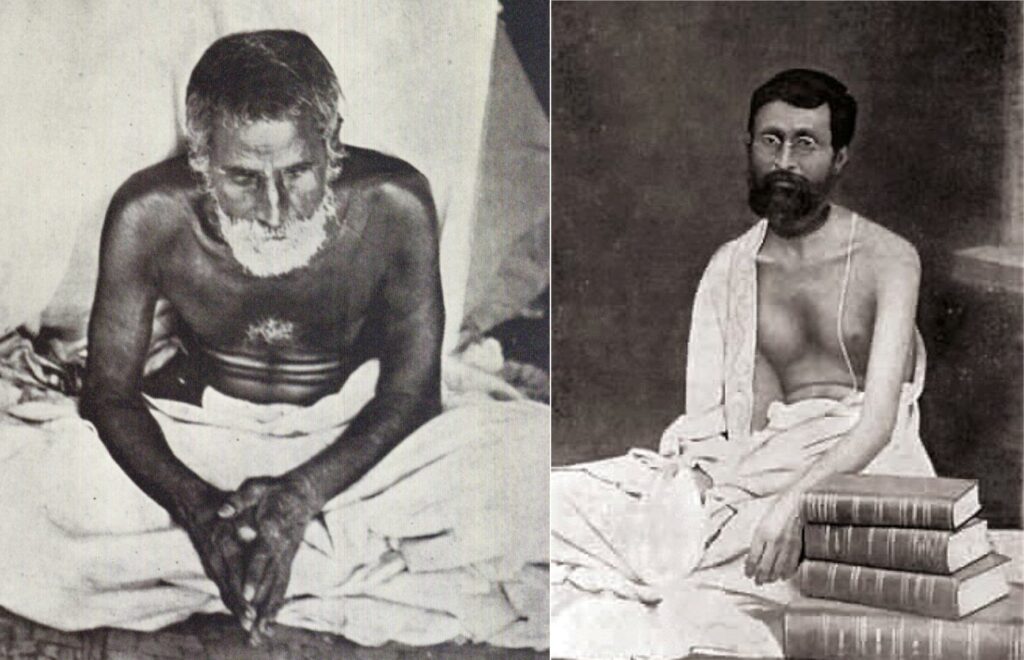
In 1898, aged around twenty-four, Srila Sarasvati Thakur visited different places of pilgrimage such as Kasi, Prayag, and Gaya. At Kasi (Benares), he had an extensive discussion with Ram Misra Shastri about the Ramanuja sampradaya. During this period the renunciate nature of his devotional life became very apparent. As early as 1897 he was observing the four months of chaturmasya with great austerity and devotion. He would eat only boiled food (habisyanna) which he cooked himself, and sleep on the floor without pillows or bedding. In 1899 he wrote various articles to preach Vaisnavism in a magazine called Nivedan, published in Calcutta.
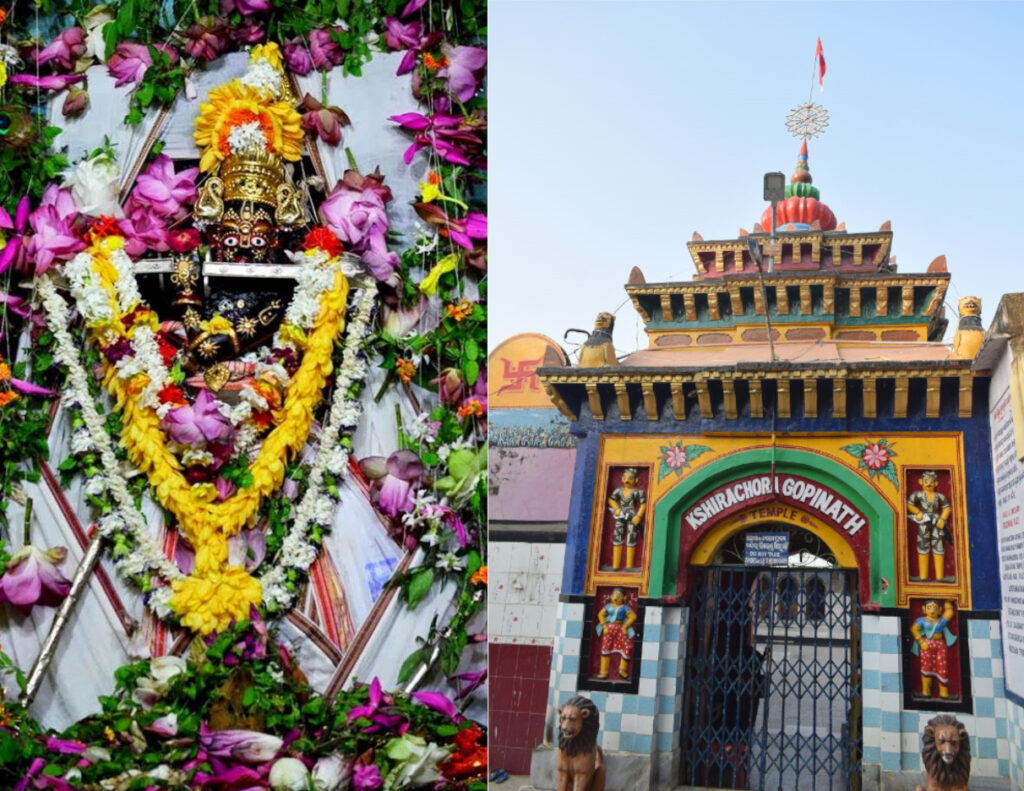
Ksirachora Gopinath Deity and Temple at Remuna
In March of 1898, Srila Sarasvati Thakur had gone to Remuna to see the Deity of Ksirachora Gopinath (Gopinath who stole the ksira, or sweet-rice pudding, for his devotee Sri Madhavendra Puri). Then he went to Puri via Bhuvaneswar. Srila Sarasvati Thakur became very attached to the holy city of Puri. His great desire was to establish a math (temple) in front of the samadhi of Srila Haridas Thakur. The subregistrar of Puri, Jagabandhu Pattanayak, and others requested him to take charge of the service of the Deity of Sri Giridhari at Satasan Math.
Srila Bhaktisiddhanta Sarasvati takes Initiation from Gaurakisora Das Babaji

In January 1900, Srila Bhaktisiddhanta Sarasvati Thakur took initiation from Gaurakishora Das Babaji on the advice of Srila Bhaktivinoda Thakur. Bhaktisiddhanta Sarasvati was Babaji Maharaj’s only disciple. Babaji Maharaj was an extremely renounced reclusive bhajananandi, who had sworn not to take any disciples. However, he was forced to change his decision when he saw Sarasvati Thakur’s determination and devotion. The story is told that Srila Bhaktisiddhanta Sarasvati asked Gaurakisora Das Babaji Maharaj several times to give him initiation. The first time he asked, Babaji Maharaj told him:
If Mahaprabhu tells me to, I will.
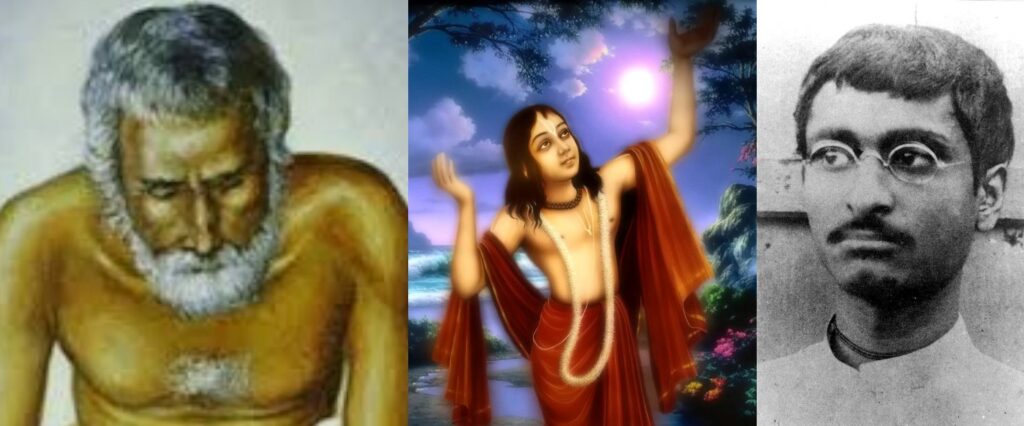
The second time, Babaji Maharaj told him that he had forgotten to ask Mahaprabhu. Srila Bhaktisiddhanta Sarasvati did not give up, and when he approached a third time, Babaji Maharaj said:
Virtuousness, scholarship and other qualities are not the means to attain the Lord. They do not give you any right to initiation.
Though he had been turned back by Gaurakisora Das Babaji repeatedly, Srila Sarasvati Thakur did not abandon his resolve. Ramanujacharya was turned back eighteen times before receiving the mercy of Goshthipurna. Srila Sarasvati Thakur displayed his qualities of patience and determination, continuing to come to Babaji Maharaj, humbly entreating him to give him initiation. Finally, Gaurakisora’s heart melted and out of great affection he mercifully initiated Srila Bhaktisiddhanta Sarasvati by sprinkling the dust of his lotus feet upon his head.
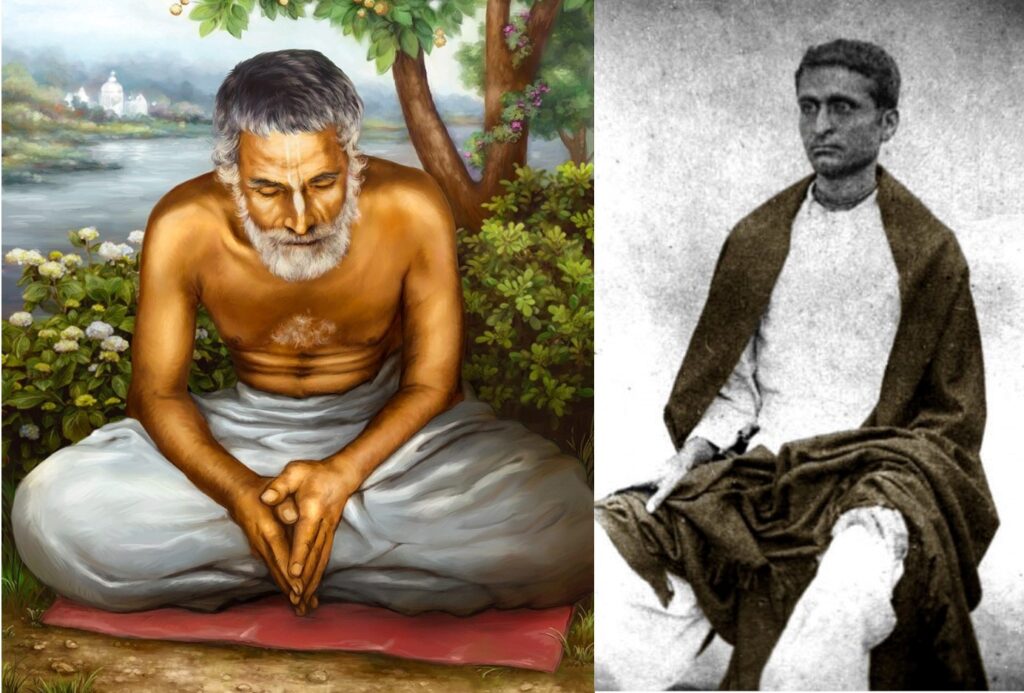
Gaurakisora Das Babaji would never allow any materialistic person to touch his feet. If they did so, he would make a show of anger, saying, “You are doomed!” Most people were thus afraid to attempt it. On this occasion, however, he himself offered the dust of his feet to his dear disciple and smeared it on his body. Afterward, Babaji Maharaj, judging Srila Bhaktisiddhanta Sarasvati to be eminently qualified for the task, blessed him and ordered him to preach Mahaprabhu’s message all around the world.
In a mood of extreme devotional humility, Srila Bhaktisiddhanta Sarasvati Thakur wrote the following words about his guru:
In order to complete the gaping needs that I felt, I was busily trying to get my hands on everything under the sun. I thought that possessions would fulfill my needs. Over time, I had indeed accumulated a great number of rare possessions, but I was not able to rid myself of the sense of being unfulfilled. I had encountered many personalities who were reputed to be great saints, but saw various lacunae [an unfilled space or lacking] in every one of them, and so was unable to give them my respect. Fortunately, the supremely merciful Sri Gauranga Mahaprabhu allowed two of his dearest companions to show their kindness to me.
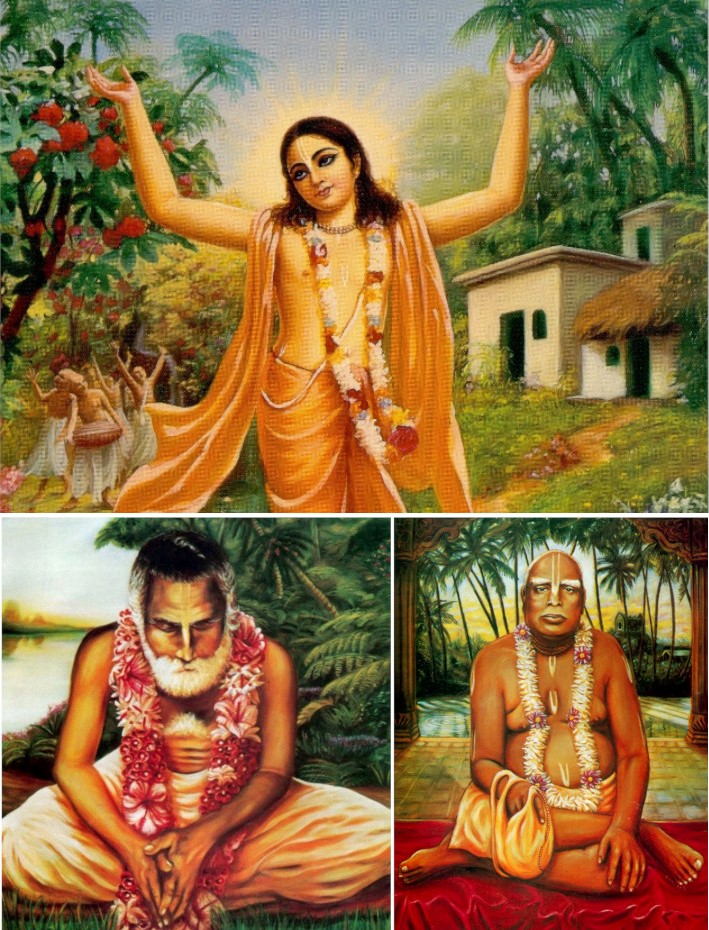
I was egotistically so self-absorbed that I had completely lost any sense of where my well-being could be found. Even so, due to past pious activities, I was able to get the association of Srila Bhaktivinoda Thakur who was my ever well-wisher. My Prabhu often came to visit him and sometimes stayed overnight at his house. Out of mercy to me, Srila Bhaktivinoda Thakur introduced me to him. From the time that I first met my Prabhu, my stubborn egoism started to diminish. Previously, I used to think that everyone who took birth in a human body was filled with the same faults that I had, but upon seeing my Prabhu’s divine character I realized that there truly were flawless Vaisnavas in this world who matched the ideal.
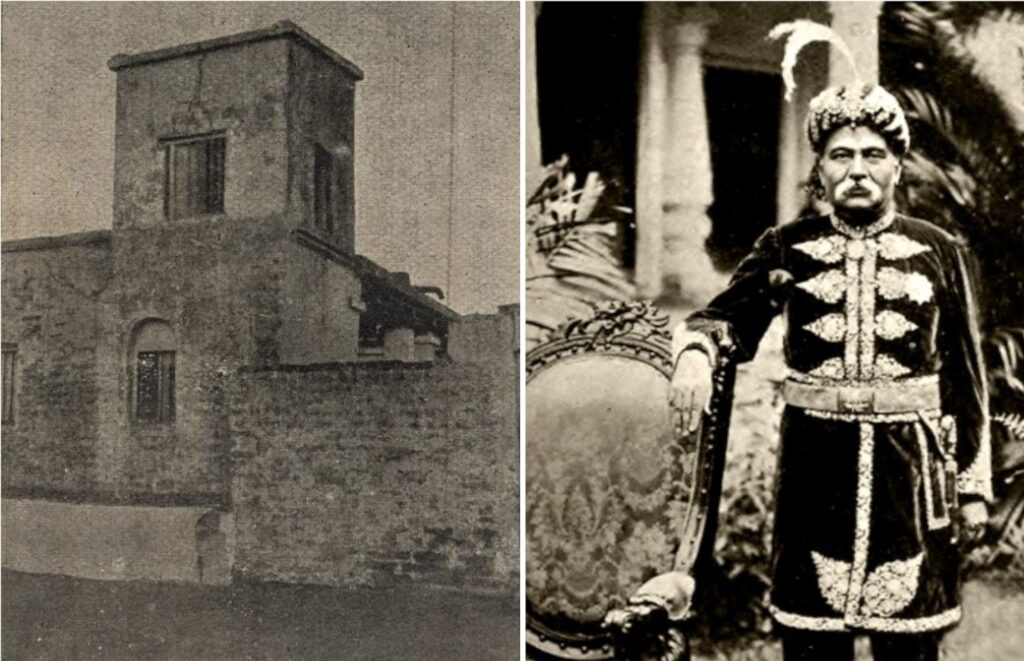
Bhakti Kuthi built by Bhaktivinoda Thakur. From his small room on top of the building, the Thakur could view the samadhi of Haridas Thakur. Maharaja Manindra Chandra Nandi
In 1902 Srila Bhaktivinoda Thakur started to build a bhajan-kutir called Bhakti Kuthi near the samadhi of Srila Haridas Thakur. The Maharaja of Kasim Bazar in Calcutta, Maharaja Manindra Chandra Nandi, who was grief stricken due to some personal tragedy, used to live there in a tent at this time and listen to the spiritual discourses of Srila Bhaktivinoda Thakur and Srila Bhaktisiddhanta Sarasvati Thakur. At this time, Srila Sarasvati Thakur regularly used to read and explain the Caitanya-caritamrta to the audience in Bhakti Kuthi, in the presence of Srila Bhaktivinoda Thakur. During this period Sarasvati Thakur labored to collect material for Vaisnava Manjusa, a Vaisnava encyclopedia.
One babaji, Radha-raman Charan Das, who lived in Puri, had concocted a song: bhaja nitai gaura radhe syama japa hare krishna hare ram. This is an example of rasabhasa, the mixing of two different rasas or devotional flavours.
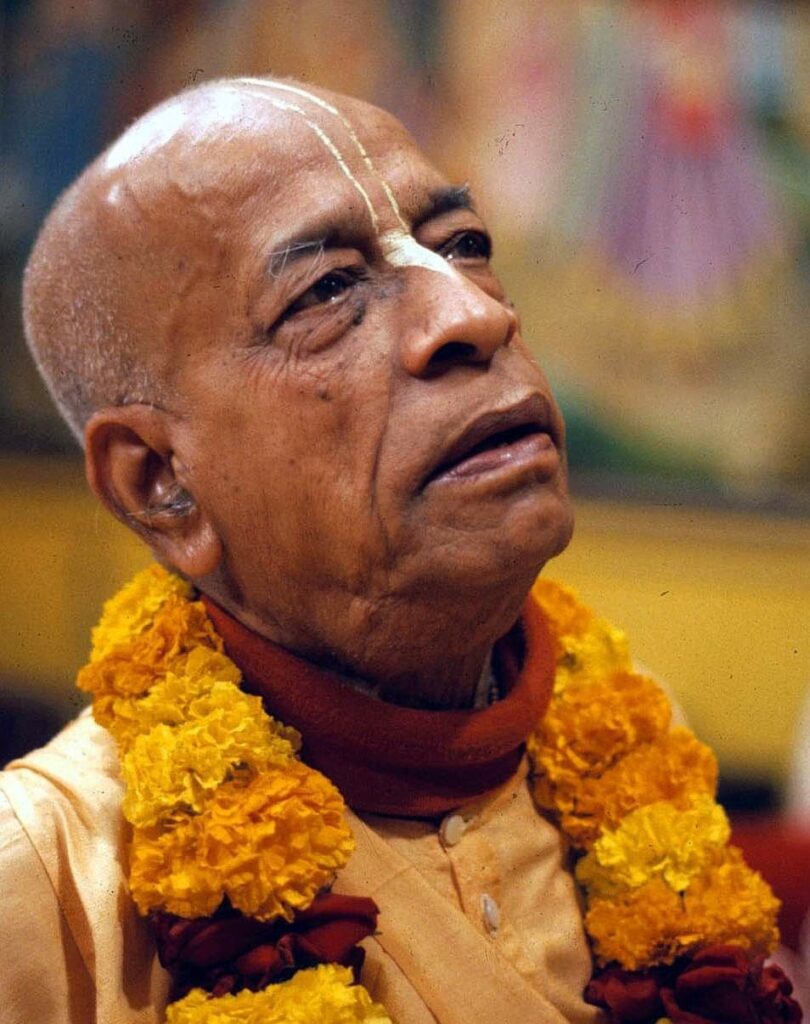
Srila Bhaktivedanta Swami has said of this:
… Although there is no difference by chanting sri-krishna-chaitanya prabhu-nityananda and Hare Krishna mantra, maha-mantra, but still by chanting this Panca-tattva [mantra], you’ll get immediately, quickly, result. Therefore our process is to chant the holy names of the Panca-tattva and then we chant Hare Krishna maha-mantra. That is perfect. And neither mixing. The mixing taste is called “rasabhasa.” Rasabhasa. And we don’t manufacture anything. Just follow. We disagree with the persons who chant that bhaja nitai-gaura radhe-syama. No. We must follow strictly. … We cannot manufacture simply for some worldly cheap reputation and prestige. If we manufacture something, that will not help us. We must follow.
[Lecture Caitanya-caritamrta Adi 7:5 March 7, 1974 Mayapur]
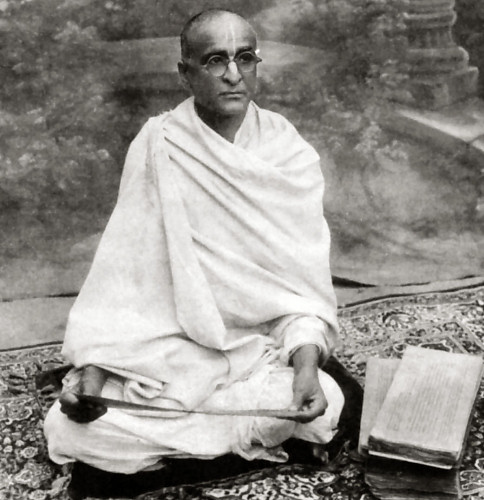
Srila Sarasvati Thakur not only protested against this, but presented a very strong argument and proved it to be inauthentic and against Vaisnava scriptures. This babaji also introduced the sakhiveki concept by dressing one of his followers as Lalita Sakhi. This sahajiya practice was against Lord Chaitanya’s teachings, since an ordinary jiva was being worshipped as though he were an expansion of Srimati Radharani. Srila Sarasvati Thakur was always a fearless and forthright speaker, and thus opposed the babaji. Those who sided with the phony babaji opposed Srila Sarasvati Thakur, and unable to defeat him in philosophical argument, they tried other ways to suppress his preaching. Although Srila Sarasvati Thakur silently tolerated this oppression, Srila Bhaktivinoda Thakur asked him to go to Mayapur and practice his bhajan there, so he could worship and preach without obstacles.
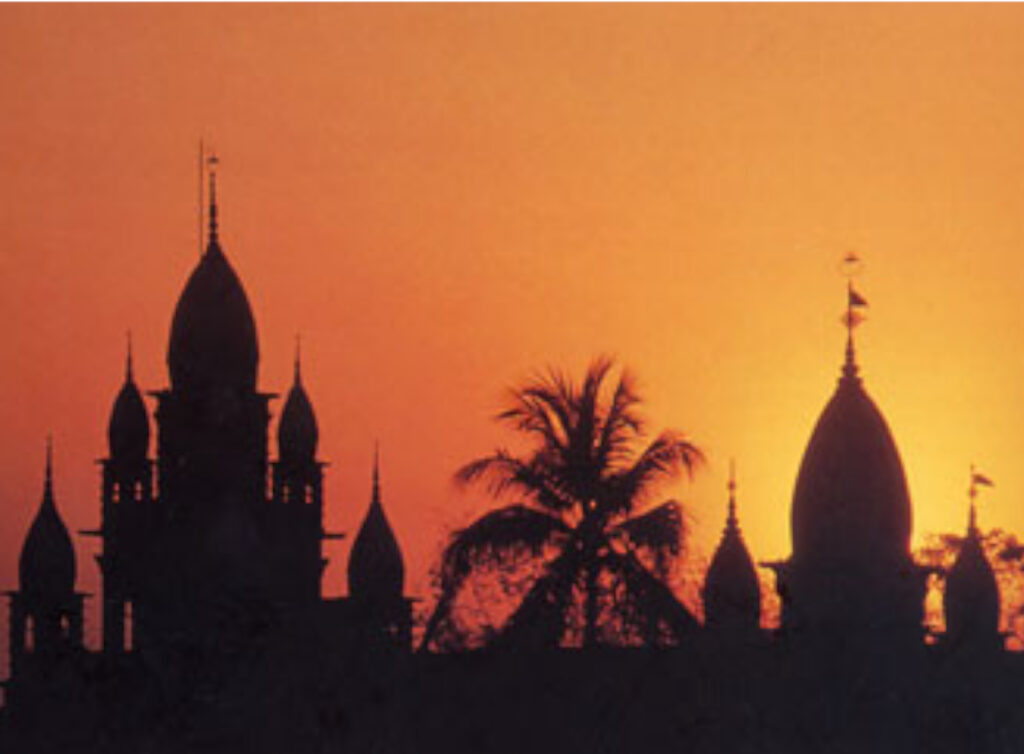
Mayapur Dhama 1905-1910
In February 1905, after retiring from the service of the Royal family of Tripura, Srila Sarasvati Thakur went on pilgrimage to various holy places in South India. After visiting Simhachal, Rajmahendri, Madras, Peremvedur, Tirupati, Kanjiveram, Kumbhakonam, Srirangam, Madura, etc., he returned to Calcutta and then went on to Sri Mayapur. In Peremvedur he gathered information about the practice of tridanda Vaisnava sannyas from a tridandi swami who belonged to the Ramanuja sampradaya.
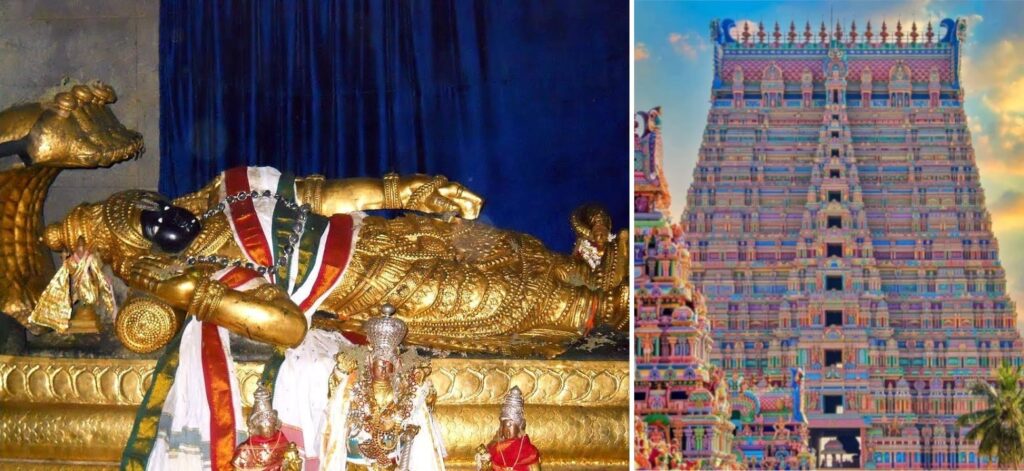
Lord Vishnu in the reclining form of Lord Ranganath and Sri Ranganath Temple at Srirangam
In 1905, at the age of 31, Srila Sarasvati Thakur took an extraordinary vow while residing in Sri Mayapur. Following in the footsteps of Srila Haridas Thakur, he would chant three lakhs [192 rounds] of the Holy Name daily. He calculated that at this rate of chanting 300,000 Names each day, it would take him nine years to chant a billion Names of Krishna, a goal he set for himself. He would sleep on the floor for only a few hours, eat very simply, and chant day and night. In the afternoon he would speak Krishna bhakti to the assembled devotees.
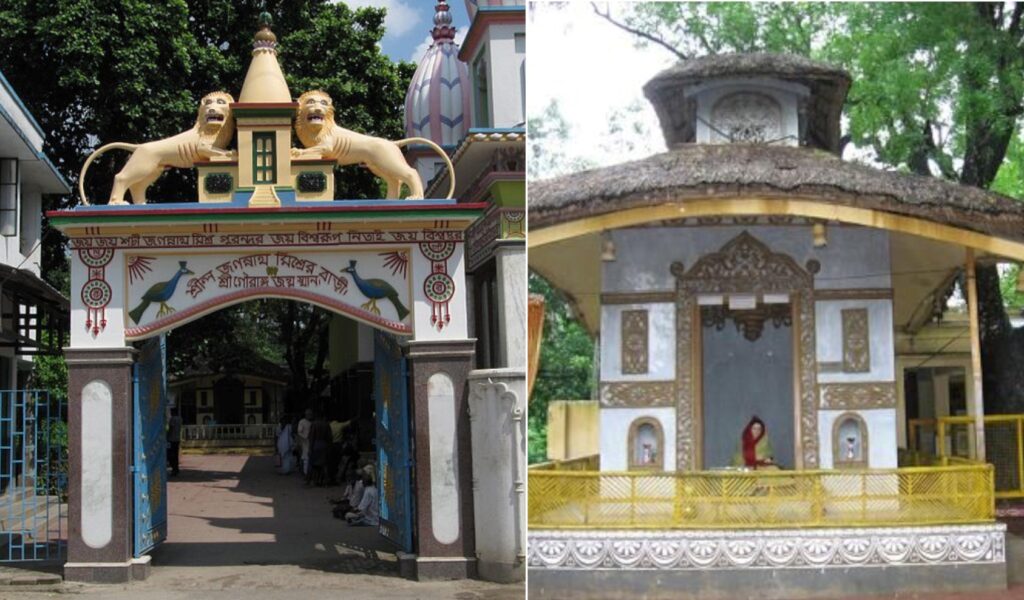
Yogapitha: The Birthplace of Lord Chaitanya
He resided in a grass hut at the Yogapitha [birthplace of Lord Chaitanya] for four years, and in February of 1909 he built a small bhajan kutir near the Yogapitha at the site of the house of Sri Candrasekhara Acarya, the maternal uncle of Sri Chaitanya Mahaprabhu. This place is considered to be non-different from the banks of Radhakunda in Vraja dham. He called this cottage Sri Vrajapattan. There he remained, uninterruptedly executing his chanting. At this time his mother, Srimati Bhagavati Devi, was staying at the Yogapitha and assisting him in his service to Sri Mayapur Dham. On some days Sarasvati Thakur would go to Kuliya to have darsan of Srila Gaurakisora Das Babaji, and receive his instruction. Srila Gaurakisora Das Babaji was very pleased to see the great renunciation of Srila Sarasvati Thakur. He used to say:
In my Prabhu I see the same kind of renunciation that was seen in Sri Rupa and Sri Raghunatha.
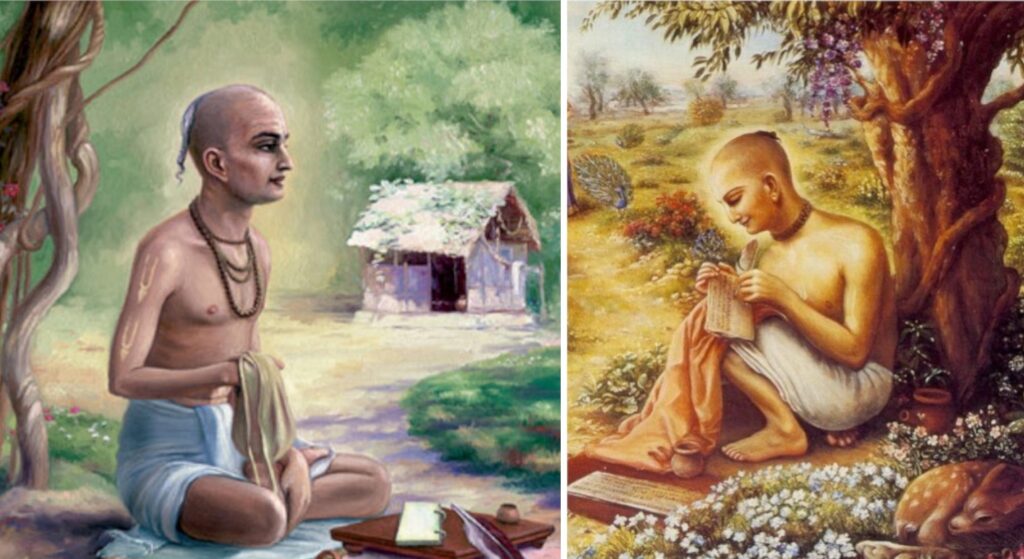
Srila Raghunath Das Goswami and Srila Rupa Goswami
Srila Babaji Maharaja used to address his disciple Srila Sarasvati Thakur as my Prabhu [“my master”]. Srila Sarasvati Thakur also received the blessings of the great Vaisnava Srila Vamsidas Babaji Maharaja in Navadvipa. Seeing Srila Sarasvati Thakur, Srila Varmsidas Babaji Maharaja would say:
Someone very close to my Gaura has come to me.
Vamsidas Babaji was a Gaudiya Vaisnava sadhu who lived at Svarupa Ganj in Godrumadvipa, during the time of Srila Bhaktisiddhanta Sarasvati Thakur. He lived as a total recluse, far away from the hustle and bustle of the town, in a solitary place on the bank of the Ganges near Baral Ghata in Navadvipa. Sometimes he appeared to those lacking spiritual vision as if he was a crazy person. Vamsidas Babaji lived in a world of his own, centered round his deities – Gaura-Gadadhara, Nitai, Radha-Krishna and Gopala. His only possessions were two brass pots, some earthen pots, one plate, one glass, some small cups, some arotika utensils, and a conch-shell.
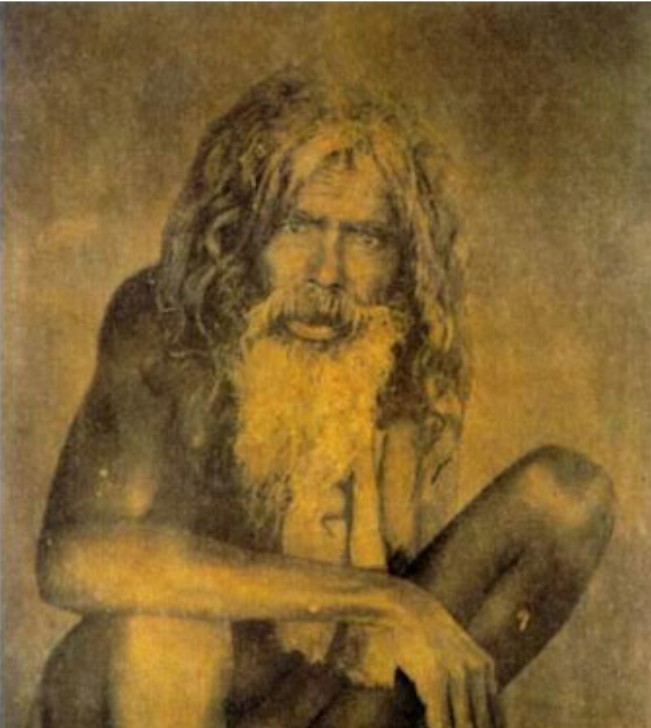
Vamsidas Babaji Maharaja
Vamsidas Babaji was respected by Srila Bhaktisiddhanta as a great Vaisnava saint. After the Gaudiya Math was established, Srila Sarasvati Thakur would ensure that Vamsidas Babaji was provided with grains and other foodstuffs by Gaudiya Math brahmacharis so that he could cook for his deities. At one time, Srila Bhaktisiddhanta Thakur called his brahmacharis together and forbade them from visiting the baba, save for one who would deliver supplies. He later called them together again and said:
Some of you think I’ve stopped you from visiting babaji maharaja because he is in maya. That is not so. I’ve prevented you because you will not be able to understand this bhava (inner devotional mood) and will only commit offences. So better you stay away.
In commenting on this period of Srila Bhaktisiddhanta Sarasvati’s life, Srila Bhaktivedanta Swami Prabhupad stated:
From childhood he was a strict brahmacari, Bhaktisiddhanta Sarasvati Gosvami Maharaja. And he underwent very severe penances for starting this world-wide movement. That was his mission.
Brahmans and Sahajiyas
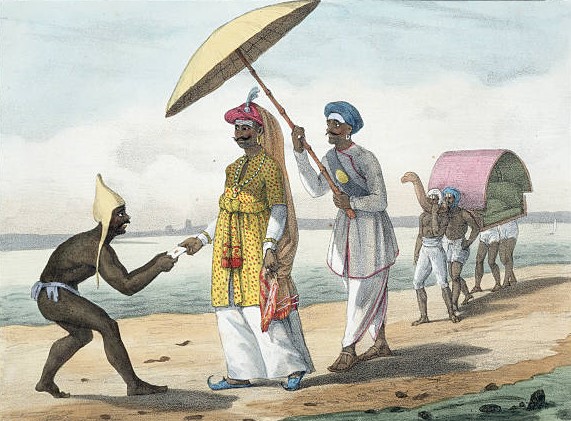
A brahman and an untouchable
Srila Sarasvati Thakur began his intense preaching of pure devotional principles in a society in which the authority of the brahmans was unquestioned, and the concept of pure devotion was misinterpreted and misrepresented by the imitators of Vaisnavism (the sahajiyas). A sahajiya is a pseudo devotee who is lacking faith that he or she can rise to perfection by carefully following the sadhana bhakti process under the guidance of a bona fide spiritual master coming in disciplic succession. Instead, they try to imitate the activities of great devotees in order to gain cheap fame and followers. Or they may claim to be an incarnation of God, or imitate Krishna’s intimate pastimes, such as dressing like Krishna and the gopis and dancing an imitation rasa dance for mundane sexual pleasure. Such activities and consciousness are condemned by all great Vaisnavas.
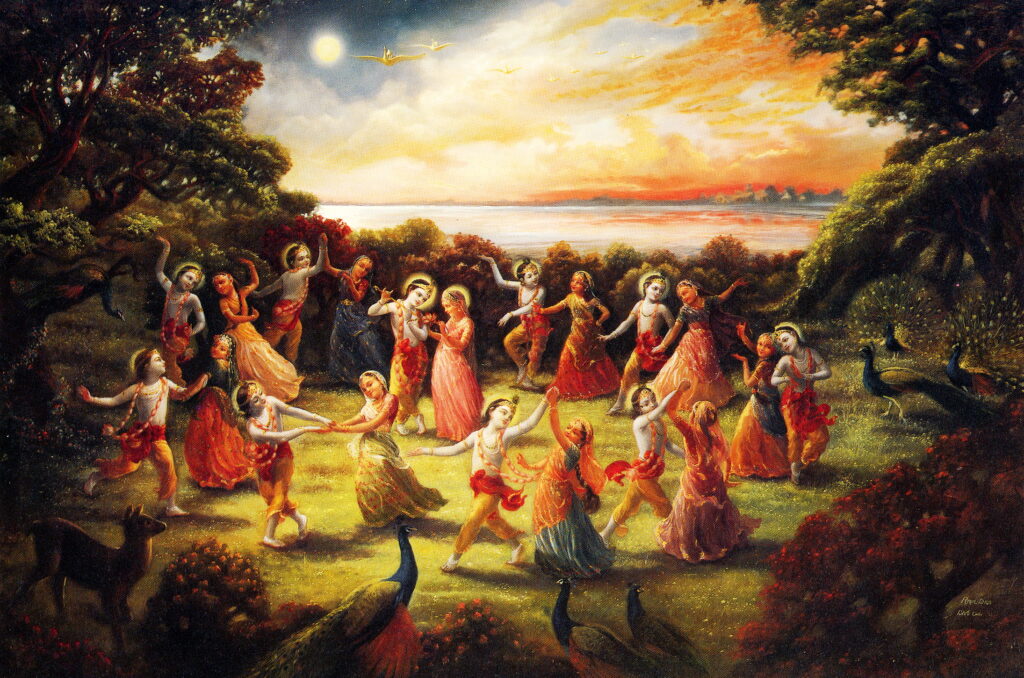
In India in the 19th and early 20th centuries, most brahmans were more concerned about following rules and regulations that had little or no connection to devotion to Lord Krishna. Their concern was largely enjoying their superior social status. Ignoring the injunctions of authentic scriptures, they neglected the responsibility of a brahman: to teach what was spiritually and morally beneficial for the rest of society. A brahman was no longer a person with brahminical qualities, but simply a person born in a family of brahmans.
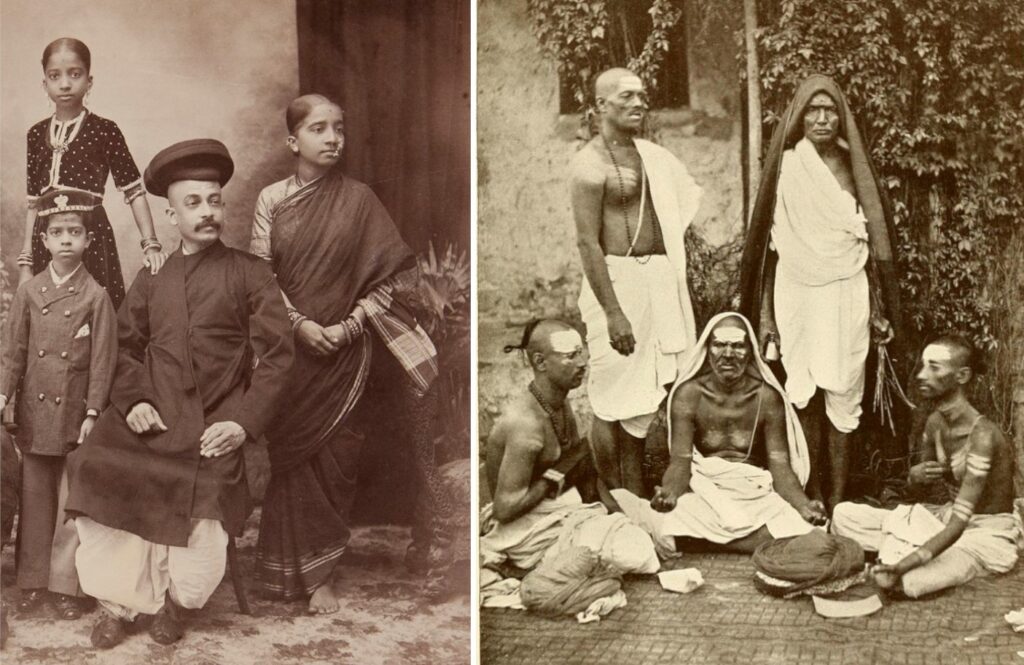
Brahmans
In the words of the Padma Purana quoted in the Sri Hari Bhakti-vilasa:
Those who have taken recourse to the devotion of Krishna are never to be considered as sudras but they are to be glorified as bhagavatas. Amongst all castes, those people who are devoid of devotion to Lord Janardana are sudras. A brahman who is expert in the six works and also in mantras and the tantra should not be selected as a guru if he is a non-Vaisnava. If someone from a dog-eater family is a Vaisnava he may be accepted as a guru. Even if one is born in the best of families, even if one is initiated in all the sacrifices and is learned in all the branches of the Vedas, if he is a non-Vaisnava he is unable to become a guru. Generally, brahmanas, ksatriyas and vaisyas should be the gurus of sudras, but even sudras can be the gurus of these three castes if they are dear to God.
[Amrta-pravaha Bhasya of Srila Bhaktivinoda Thakur]
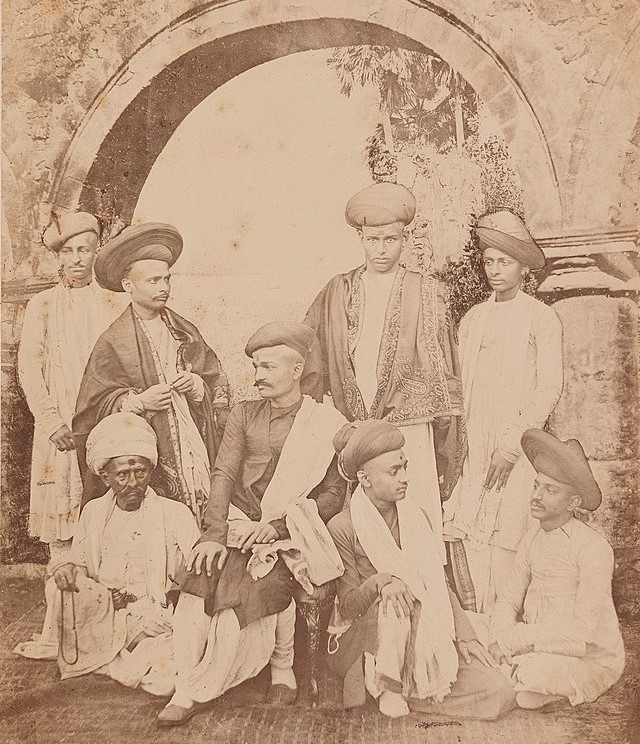
Brahmans
Since the caste system was rotting at its core, it had become meaningless and was in fact detrimental to the spiritual and moral welfare of society. The brahmans opposed any ideas that might threaten their preeminence within society. Many educated people had lost their faith in the beneficial role of the brahman class, but they did not know who could take their place. The pure Vaisnavas had for many years led reclusive lives hidden from the public eye, and the sahajiya Vaisnavas aroused more hatred and suspicion than respect. In this context, Srila Bhaktisiddhanta wanted to establish the principles of daivi-varnasrama dharma – the system in which the service of the Lord is placed in the center of society, a true Vaisnava is respected by everyone else, and one’s caste is ascertained according to one’s natural tendency, not according to one’s birth:
Brahmanas, ksatriyas, vaisyas and sudras are distinguished by their qualities of work, O chastiser of the enemy, in accordance with the modes of nature.
[Bhagavad-gita 18:41]
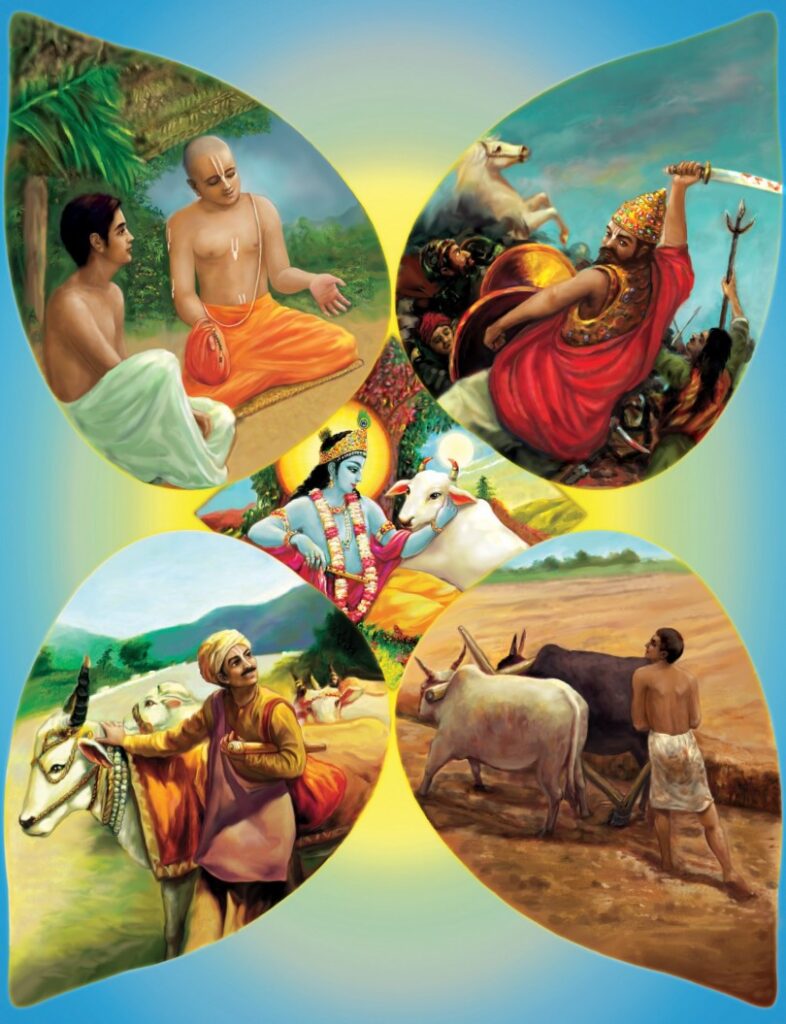
The four varnas: brahman, ksatriya, vaishya and sudra are determined by a person’s qualities of work and not by birth
Srila Bhaktisiddhanta Sarasvati Thakur’s teachings were perfectly in harmony with those enunciated by Chaitanya Mahaprabhu. Lord Chaitanya made Haridas Thakur, who was born in a Moslem family, the “Namacharya” or foremost teacher of the Holy Names. Haridas was not allowed to enter the Temple of Lord Jagganath because of his birth outside the Hindu varnas, but Lord Chaitanya would personally come to visit him where he sat chanting the Holy Names in great ecstasy.
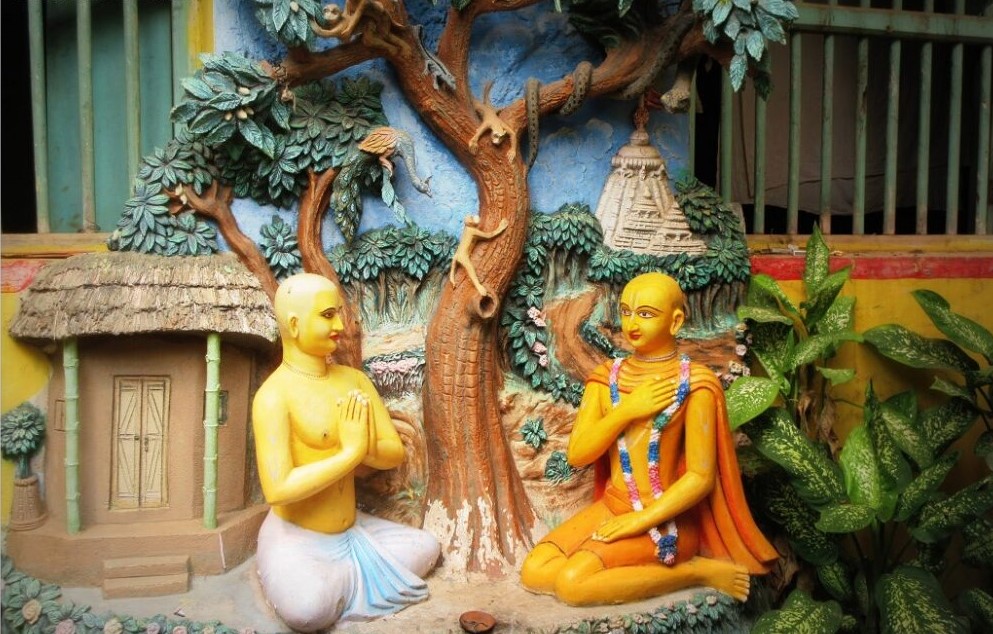
Srila Haridas Thakur being visited by Lord Chaitanya
At one Rathayatra Festival at Puri, Lord Chaitanya prayed before the chariot of Lord Jagannath:
I am not a brahman, I am not a ksatriya, I am not a vaisya or a sudra. Nor am I a brahmacari, a householder, a vanaprastha or a sannyasi. I identify Myself only as the servant of the servant of the servant of the lotus feet of Lord Sri Krishna, the maintainer of the gopis. He is like an ocean of nectar, and He is the cause of universal transcendental bliss. He is always existing with brilliance.
[Caitanya-caritamrta Madhya 13:80]
A Letter from Srila Bhaktivinoda Thakur
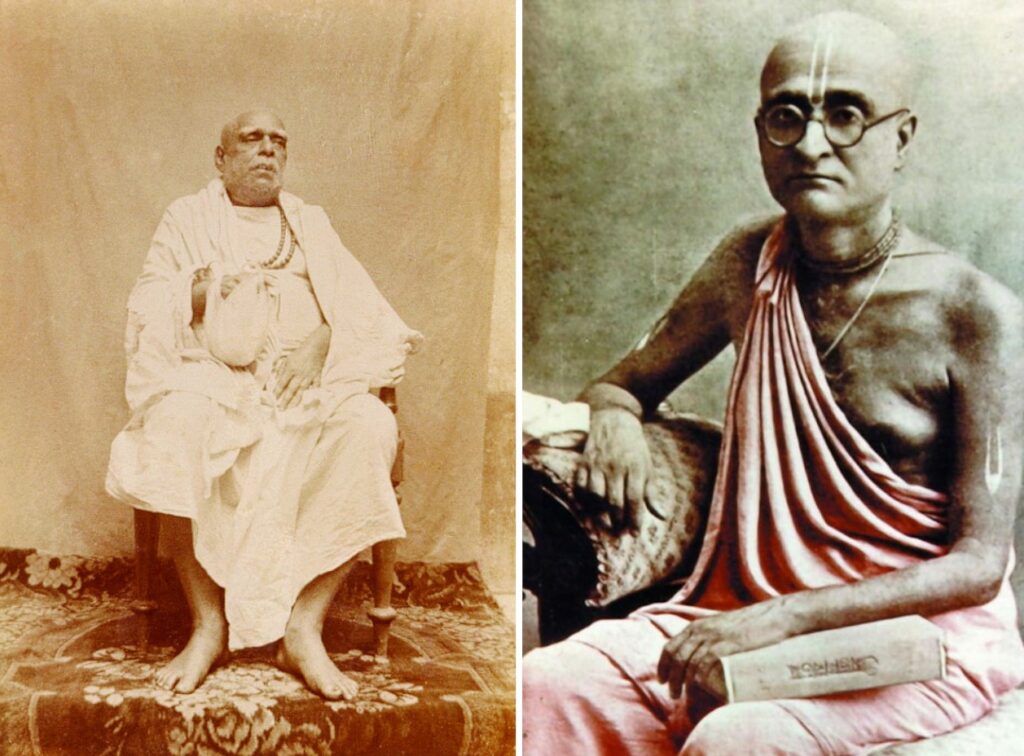
Srila Bhaktivinoda Thakur was very concerned that pure Vaisnavism was being overshadowed by many other wrong concepts and also by imitators. He felt that Srila Sarasvati Thakur was the most qualified person to preach pure Vaisnavism, having more enthusiasm, courage, knowledge and spiritual purity than anyone else. Therefore, Thakur Bhaktivinoda wrote him a letter:
Saraswati!
People of this world who are proud of their own aristocratic birth cannot attain real aristocracy. Therefore they attack the pure Vaisnavas, saying, “They have taken birth in low class families because of their sins.” Thus they commit offenses. The solution to this problem is to establish the order of Daivi-Varnasrama Dharma – something you have started doing. You should know that to be the real service to the Vaisnavas. Because pure devotional conclusions are not being preached, all kinds of superstitions and bad concepts are being called “devotion” by such pseudo-sampradayas as sahajiya and atibari. Please always crush these anti-devotional concepts by preaching pure devotional conclusions and by setting an example through your personal conduct.
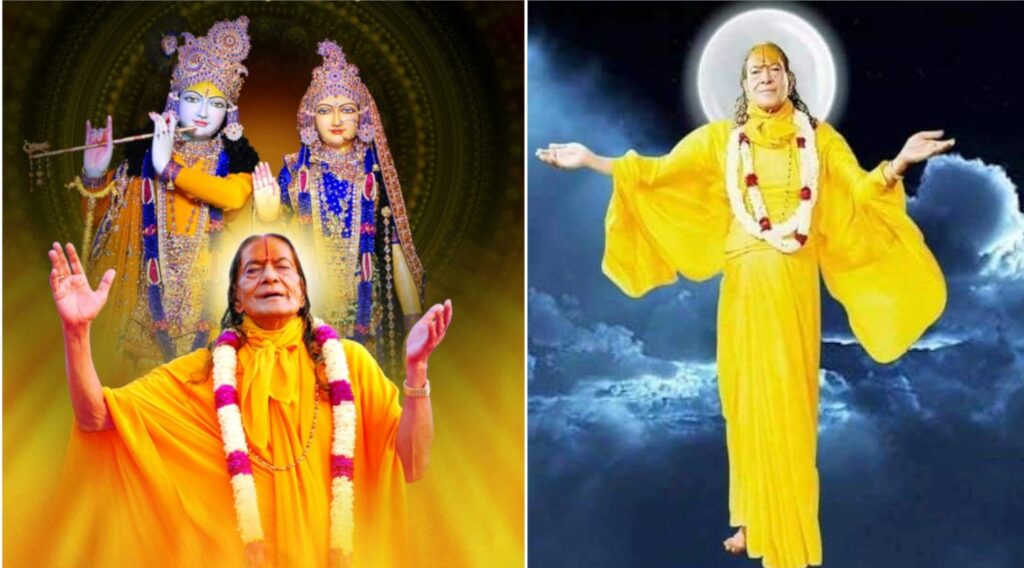
A sahajiya “guru” imitating Lord Chaitanya
Please make great effort so you can start the parikrama [circumambulation] of Sridam Navadwip as soon as possible. It is by those actions that everyone in this world will receive Krishna-bhakti [devotional love for the Lord]. Please try very hard to make sure that the service to Sri Mayapur will become a permanent thing and will become brighter and brighter every day. The real service to Sri Mayapur can be done by acquiring printing presses, distributing devotional books, and preaching congregational chanting (not reclusive bhajan). Please do not neglect to serve Sri Mayapur or to preach for the sake of your own reclusive bhajan.
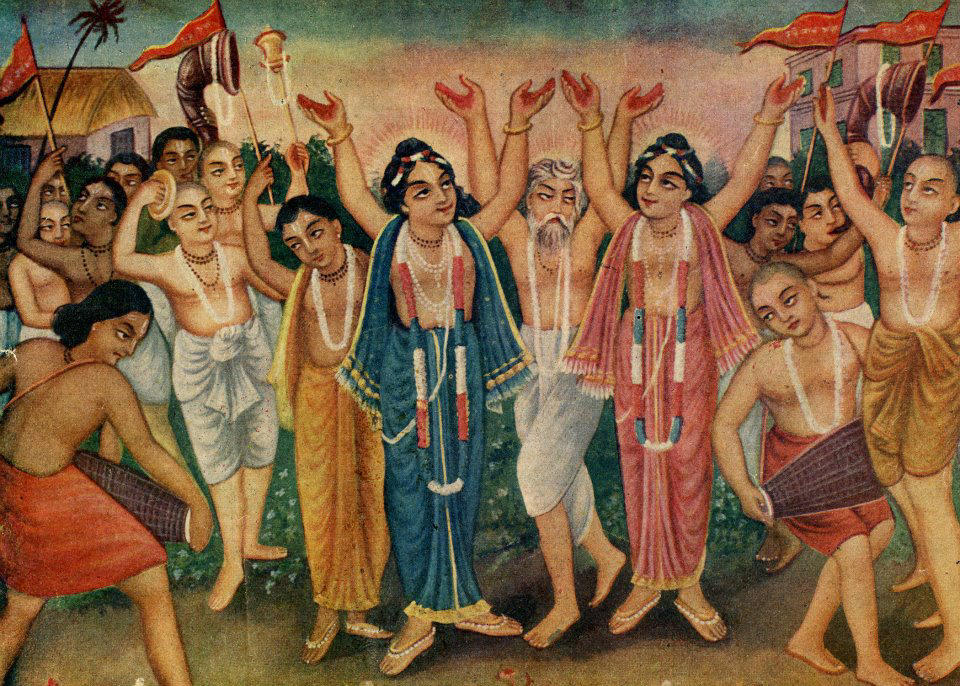
Congregational chanting
When I am not present any more, please take great care to serve Sri Mayapur Dham which is so dear to you. This is my special instruction to you. People who are like animals can never attain devotion; therefore, never take their suggestions. But don’t let them know this, directly or indirectly. I had a special desire to preach the significance of such books as Srimad Bhagavatam, Sat Sandarbha, and Vedanta Darsan. You have to accept that responsibility. Sri Mayapur will prosper if you establish an educational institution there. Never make any effort to collect knowledge or money for your own enjoyment. Only to serve the Lord will you collect these things. Never engage in bad association, either for money or for some self-interest.
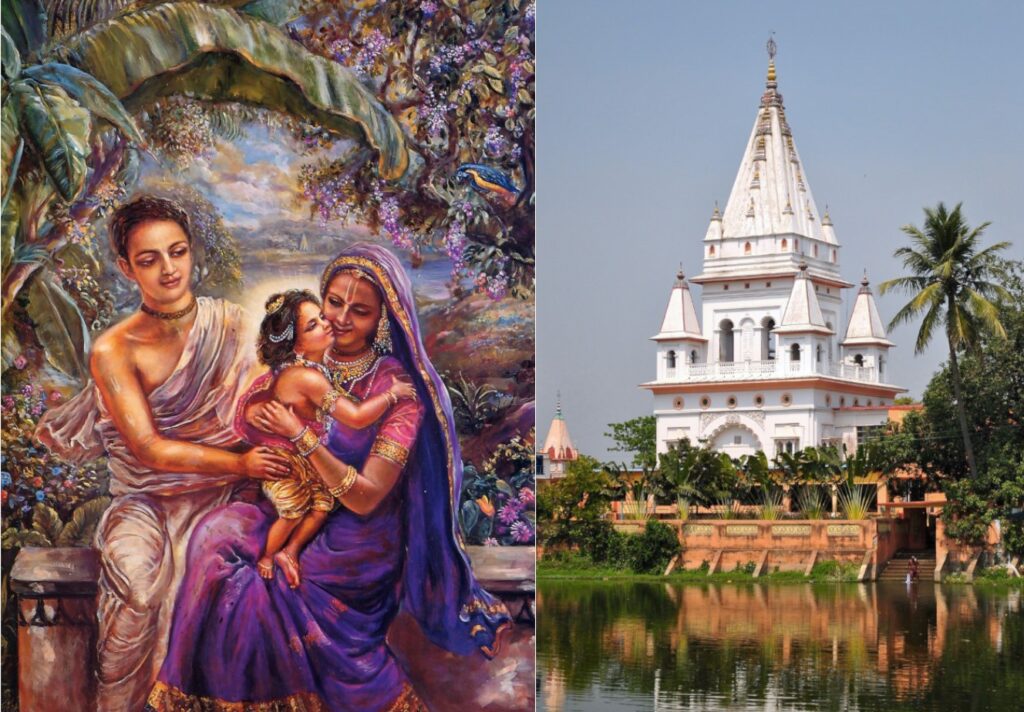
Baby Nimai and Temple at Yogapitha
Vaisnava devotees who were in contact with Srila Bhaktivinoda Thakur and Srila Sarasvati Thakur knew that the relationship between them was not mundane, like that between an ordinary father and son. Their relationship with each other was completely transcendental – like that between Guru and disciple – as is evident in this letter. Srila Sarasvati Thakur became progressively more enthused to preach pure Vaisnavism. Apart from teaching Krishna bhakti and leading congregational chanting, he also started collecting facts about the four Vaisnava sampradayas [disciplic successions]. He started writing and publishing articles about various Vaisnava acharyas in Sajjan Tosani.
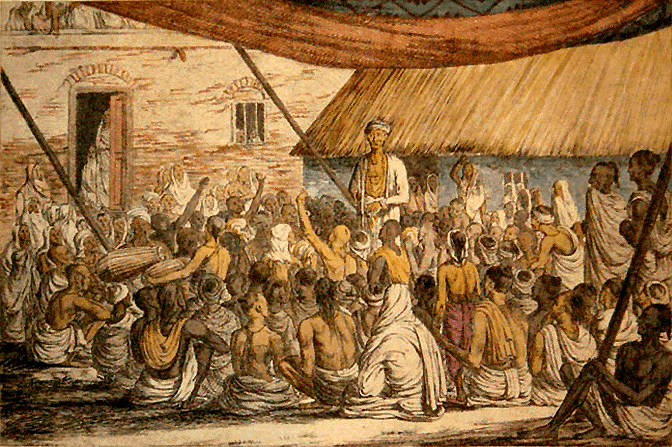
In 1906, a young gentleman called Sri Rohini Kumar Ghosh came to visit Srila Sarasvati Thakur. He was the nephew of a High Court judge, Sri Chandra Madhav Ghosh of Barishal. Rohini Babu gave up his home life to have a devotional life in Navadvipa. He found a guru from the Baul apasampradaya [one of the pseudo-Vaisnava groups – “apasampradaya” means outside of the authorised Vaisnava disciplic successions] and started residing in his asrama. The “guru” and his female companion were actually sinful rascals in the guise of devotees. One afternoon, while visiting Mayapur, he came to Srila Sarasvati Thakur and heard some invaluable devotional instructions from him.

Rohini Babu was deeply touched by this discussion, and when he came back to the asrama that night, it was all he could think about. Feeling ill, he went to bed. That night, he had a dream in which that Baul Guru and his female companion came as tigers to devour him, as he tried desperately to take shelter of Lord Chaitanya. At that moment, Srila Sarasvati Thakur came to rescue him from this danger, chasing the tigers away and leading him to Mayapur. The next morning, when Rohini Babu was awakened by the sunlight streaming through his window, he immediately left that asrama and set off for Mayapur, where he listened to discourses from Srila Bhaktisiddhanta Sarasvati for several days. Finally, he begged for initiation from his saviour so feelingly that Siddhanta Sarasvati took mercy on him. He became the first disciple of Srila Bhaktisiddhanta Sarasvati Thakur.
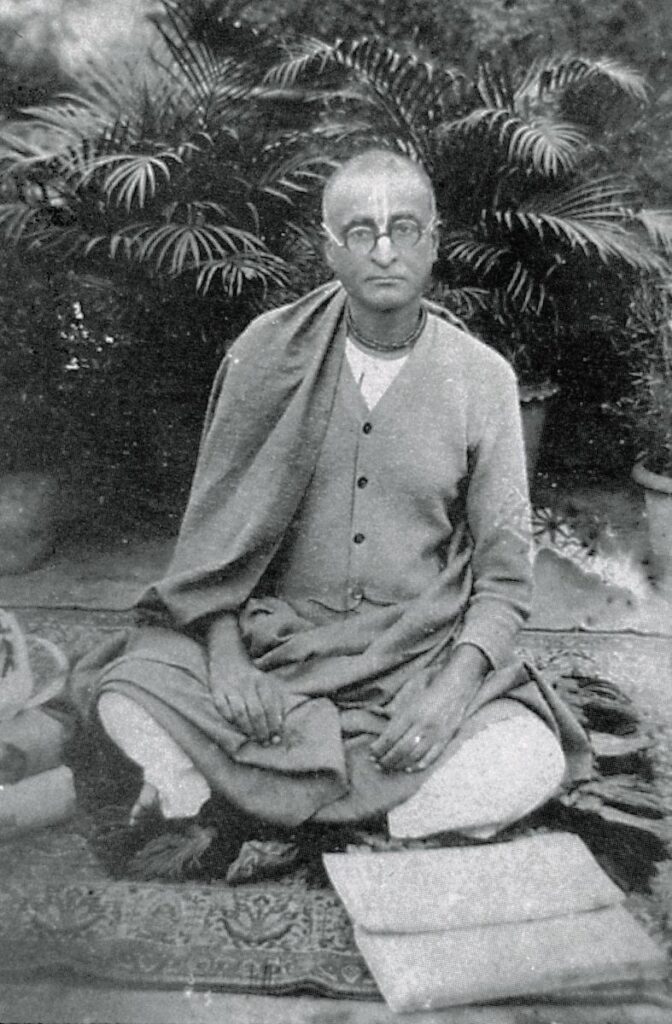
Conflict Between Brahmans and Vaisnavas in 1911
In 1911 the Vaisnava devotees were confronted by a great deal of hostile criticism from the orthodox brahmans of Bengal, known as the Smarta Samaj. In the Smarta tradition, five deities are worshipped: Shiva, Vishnu, Surya [the sun God], Ganesh and Shakti [Durga], with all treated as being equal. It is clearly stated in the Padma Purana that it is an offence against the Lord’s Holy Names to view the various demigods as being on an equal level to Lord Krishna or Lord Vishnu. And Lord Krishna says of demigod worship in Bhagavad-gita:
Men of small intelligence worship the demigods, and their fruits are limited and temporary. Those who worship the demigods go to the planets of the demigods, but My devotees ultimately reach My supreme planet.
[Bhagavad-gita 7:23]
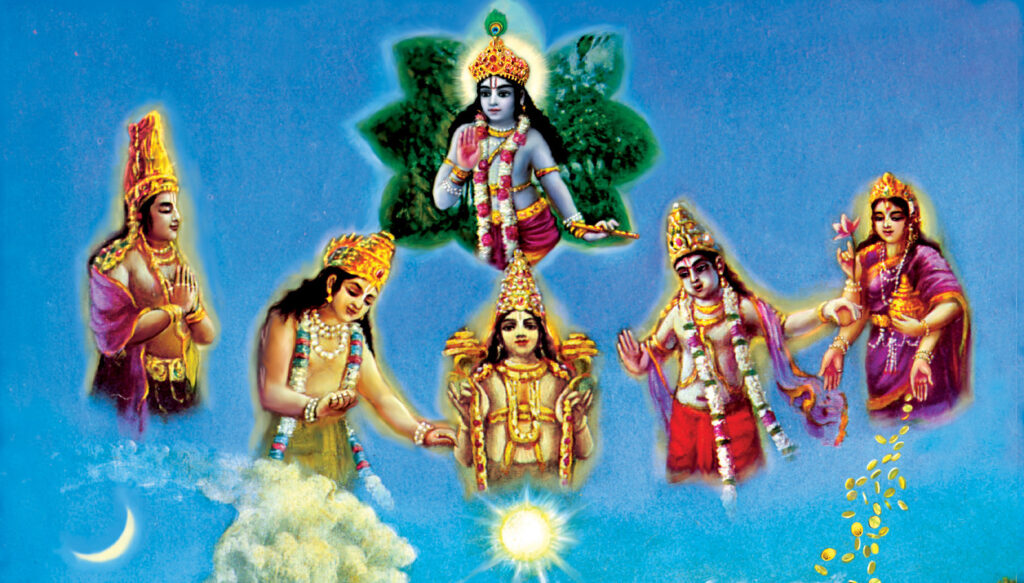
The demigods are subordinate servants of Lord Krishna
There is no way you can convert into Smartism the way you can into Vaisnavism or Saivism [worship of Lord Shiva] etc. Smarta brahmans believe one must be born to Smarta parents to become a Smarta brahman. They also believe that they are the original pure brahman sect, from which every other brahman sect sprang. The Smarta tradition is notable for the domestic worship of five shrines with five deities, all treated as equal – Shiva, Vishnu, Surya, Ganesh and Shakti [Goddess Durga].
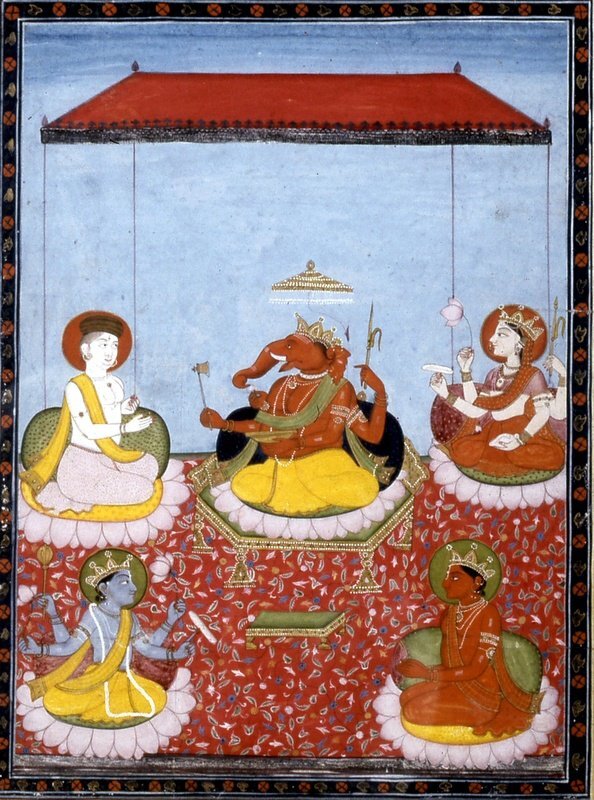
The five main deities of Smarta worship: Shiva, Ganesh, Shakti [Goddess Durga], Vishnu and Surya
The Smarta tradition regards Shankaracharya [Adi Shankara] as its founder or reformer. Shankara taught that the ultimate reality is impersonal and nirguna [attributeless] and that any “symbolic god” serves the same equivalent purpose. Inspired by this belief, the Smarta tradition followers, along with the five “Hindu gods” include a sixth “impersonal god” in their practice. In other words, they wrongly conclude that God is impersonal Brahman, and that one can worship any demigod and it is the same as worshipping Krishna, Vishnu or other Vishnu tattva forms. Ultimately, Smartas believe that the form of Vishnu or Krishna, like the forms of the demigods, are made of material energy and cannot exist beyond the material world.
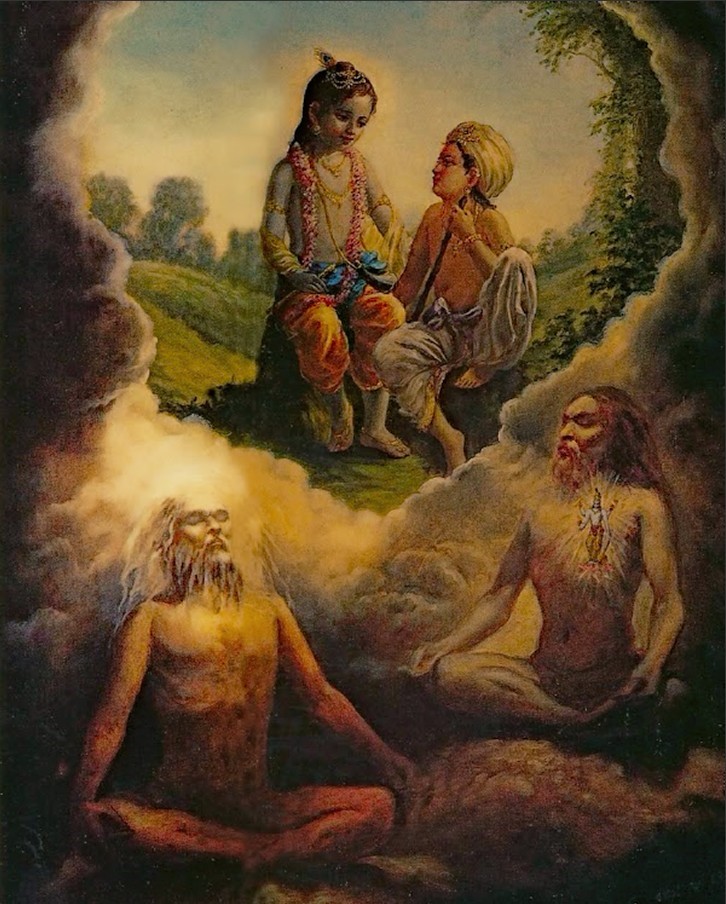
They believe that the spiritual world is formless and attributeless spirit. The worship of the Smarta brahmans is therefore pseudo bhakti, as the deities they temporarily “worship” must be abandoned when the “worshipper” enters the impersonal Brahman. The Smartas, like most impersonalists, are unaware that the impersonal Brahman, the “ocean of light,” is merely the aura or glowing effulgence springing from the transcendental bodily form of Lord Sri Krishna:
O my Lord, O primeval philosopher, maintainer of the universe, O regulating principle, destination of the pure devotees, well-wisher of the progenitors of mankind – please remove the effulgence of Your transcendental rays so that I can see Your form of bliss. You are the Supreme Personality of Godhead, like unto the sun (luminous), as am I.
[Sri Isopanisad mantra 16]
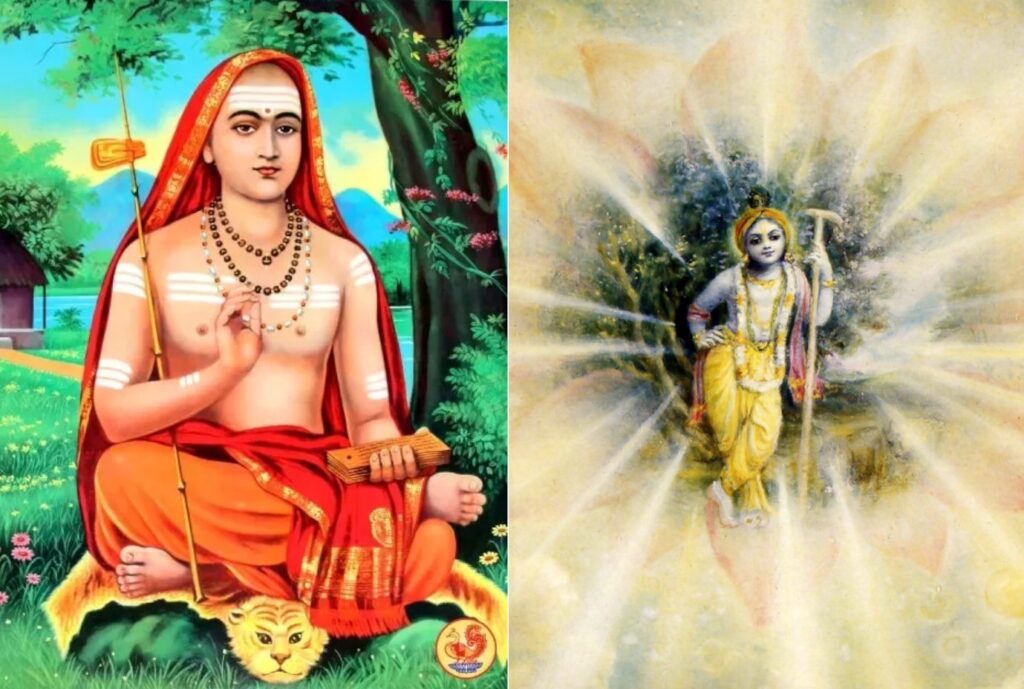
Adi Shankara and Lord Krishna showing the Brahman effulgence as His bodily effulgence
What the Upanishads describe as the impersonal Brahman is but the effulgence of His body, and the Lord known as the Supersoul is but His localised plenary portion. He is the Supreme Personality of Godhead, Krishna Himself, full with six opulences. He is the Absolute Truth, and no other truth is greater than or equal to Him.
[Caitanya-caritamrta Adi 1:4]
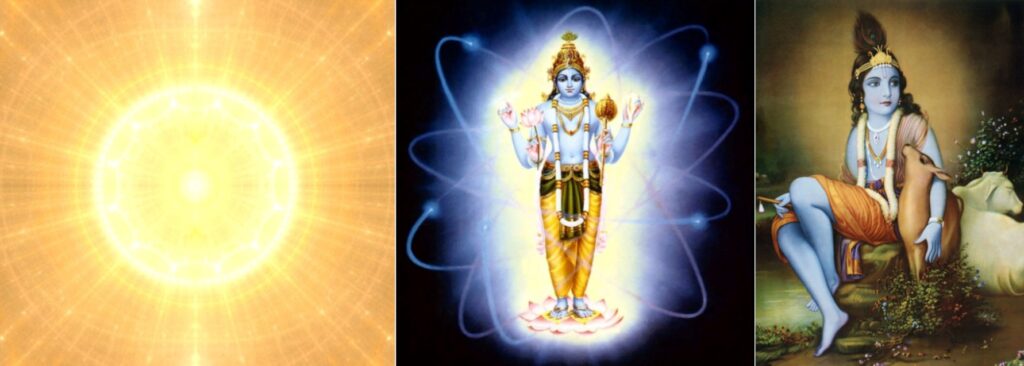
The Three Aspects of the Absolute Truth: Brahman, Paramatma and Bhagavan
These brahmans, lacking in real scriptural knowledge, were very proud of their own birth and social position, and their rituals, rules and regulations. Because of their elevated social status, it was easy for them to influence the masses, who were ignorant of pure devotional conclusions. Even some Vaisnava devotees supported the brahmans in order to get some favour from them. At this time, Srila Bhaktivinoda Thakur was ill and bedridden. But he was still very concerned about the situation and wanted someone to confront the brahman pandits face to face. Following Srila Bhaktivinoda Thakur’s desire, and having been so requested by the famous scholar Sri Madhusudan Goswami of Vrindavan, Srila Bhaktisiddhanta Sarasvati arranged a meeting with the brahman pandits at the town of Balighai, in Medinipur district. Pandit Sri Visvambharananda Dev Goswami presided over this meeting.
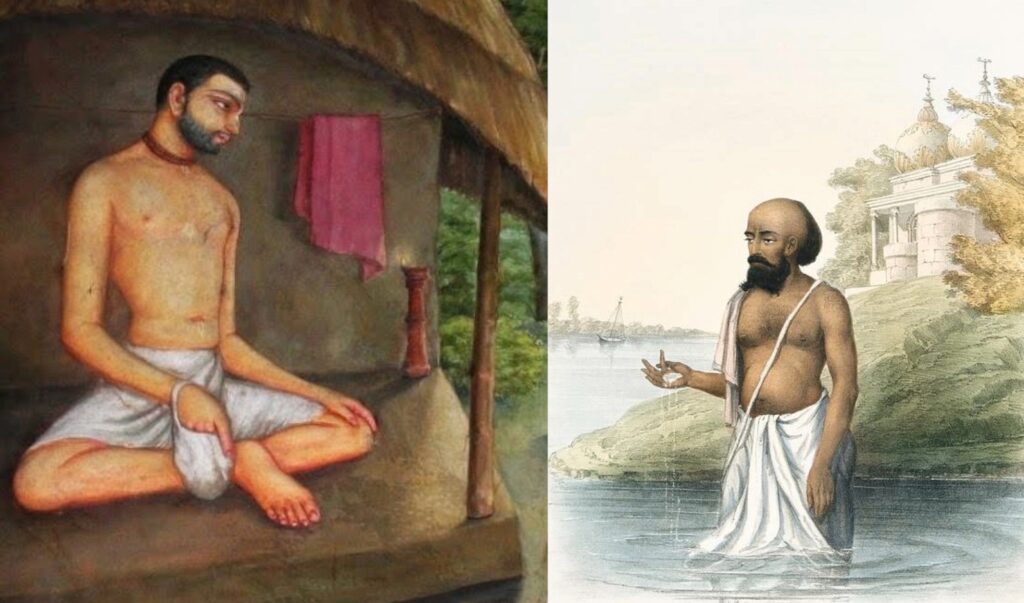
Haridas Thakur was persecuted by the caste brahmans but adored by Lord Chaitanya
Srila Bhaktisiddhanta Sarasvati read there his famous article, “Brahman and Vaisnava.” Prior to the meeting, Srila Bhaktisiddhanta Sarasvati read this work to Srila Bhaktivinoda Thakur. The Thakur was so ecstatic when he heard the powerful logic and scriptural evidences put forward by his brilliant son that he sat up in his sick-bed and proclaimed:
Sarasvati, truly, truly Sarasvati! Truly, truly he is the acarya-sun illuminating the face of the Vaisnava world. By the light of these judgements the darkness of the Karmajada Smartas’ doctrine will certainly soon be dispelled!
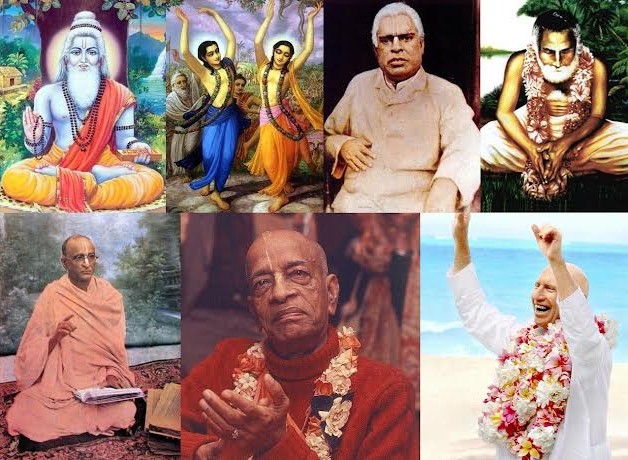
When he arrived, the assembled scholars were sitting in two different groups: those who believed in the superiority of brahmans over all other classes of people, and those who believed in the superiority of Vaisnavas, irrespective of birth or social position, over all other classes of people. At first Srila Bhaktisiddhanta Sarasvati quoted from many scriptures glorifying brahmans.The joy of the assembled brahmans knew no bounds, because even they did not know that there was so much glorification of brahmans in so many different scriptures.
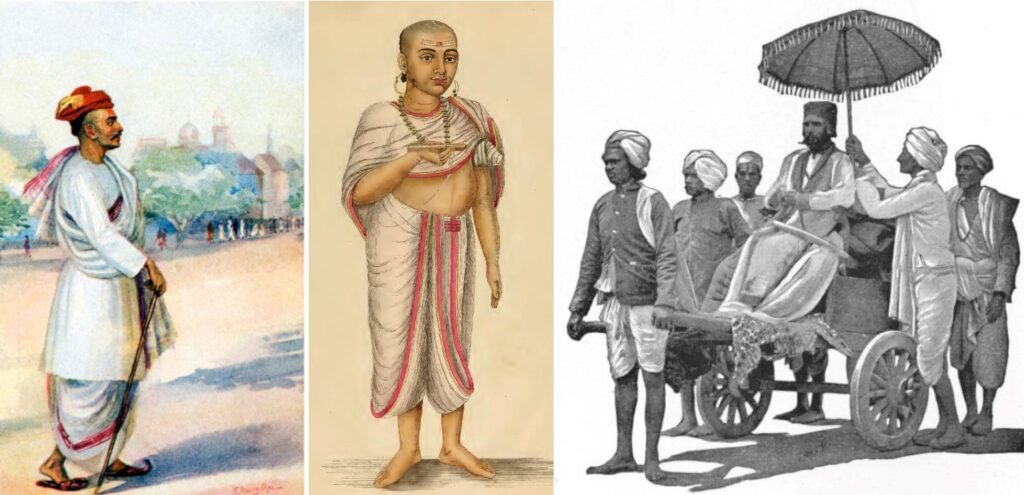
Many brahmans were proud of their birth and social position
But then Srila Sarasvati Thakur started his glorification of Vaisnavas, again based on scripture, which far exceeded the glorification of brahmans in quality and quantity. This time the brahman pandits were not so pleased. Unable to respond to the evidence presented by the greatest scholar of his day, they started shouting. One or two of them desperately tried to present new arguments, but Srila Bhaktisiddhanta Sarasvati crushed their dissent by dint of his scriptural knowledge and irrefutable logic. He personally answered all questions and refuted all arguments by the brahmans, and thus established the superiority of pure devotees of the Lord over all classes of people.
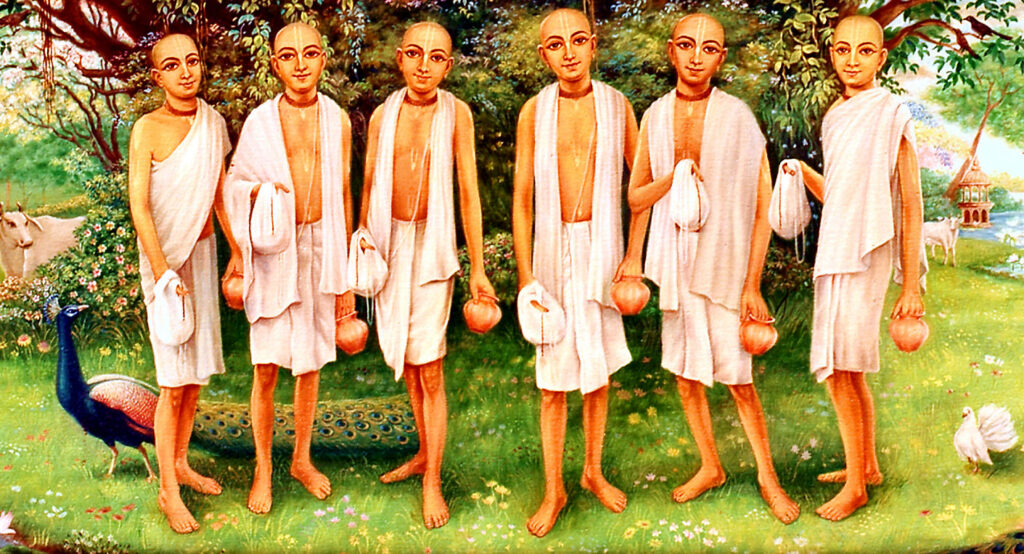
Great Vaisnavas: The Six Goswamis of Vrindavan
The meeting went on in this way for three days. Backing up Siddhanta Sarasvati were Sri Madhusudana Gosvami, Sarvabhouma Sriyukta Ramananda Das Babaji, and Sriyukta Sitanatha Bhaktitirtha Mahodaya. They all offered strong arguments that no matter what family a Vaisnava appears in, he is perfectly qualified to recite the Vedas. On the final day, Siddhanta Sarasvati was the concluding speaker. He spoke brilliantly with great vigour and incredible rhetoric for two hours. When he finished, no one on the opposing party could say a word. There was simply no way to counter him. There was a huge uproar in acclaim of the brilliant acharya.
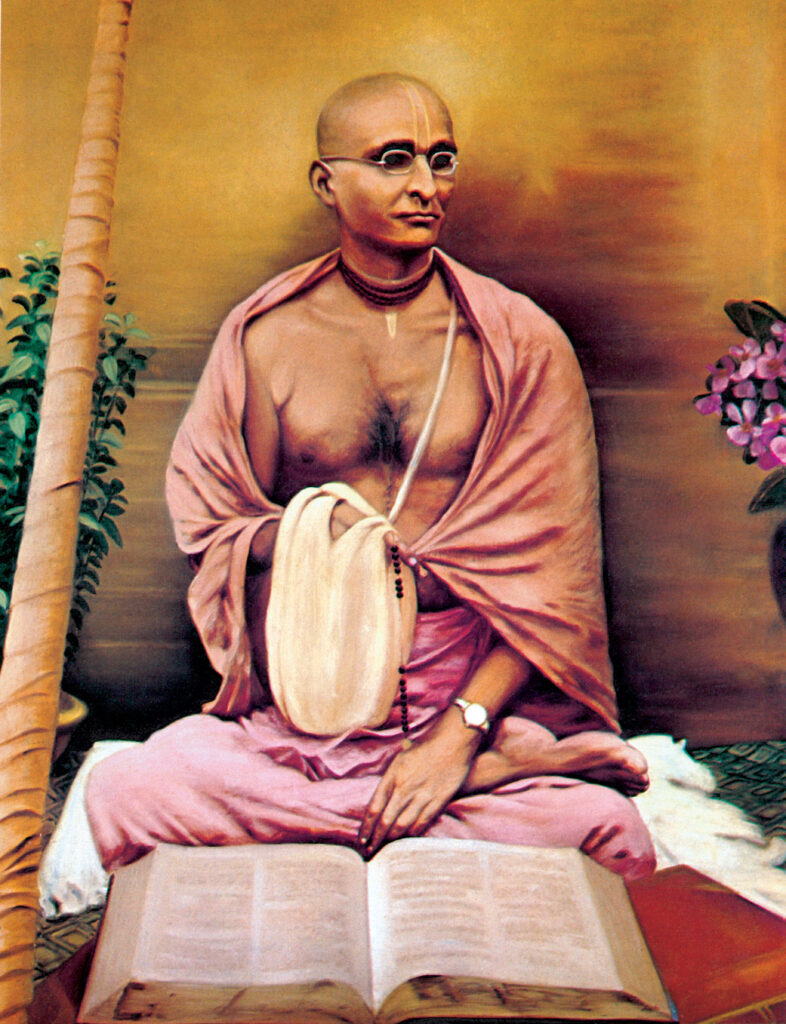
Thousands of people rushed forward to take the dust of his lotus feet. The guards pleaded with the people to remain peaceful, and they would certainly have their desires fulfilled. Taking Bhaktisiddhanta Sarasvati to a separate place, the guards forcibly took his feet and dunked them into a basin of water. The acarya objected strongly, as it was his principle not to allow anyone to touch his feet, and if anyone offered obeisances to him, he would immediately offer them obeisances in return. Yet the guards, desiring to protect him from the press of the crowd, took this action, adding a few buckets of water to the quantity and distributed it to the crowd. In this way the people felt satisfied and blessed, and they exhausted the entire supply in no time. Srila Bhaktisiddhanta Sarasvati Thakur was thus acclaimed as the greatest hero of the conference.
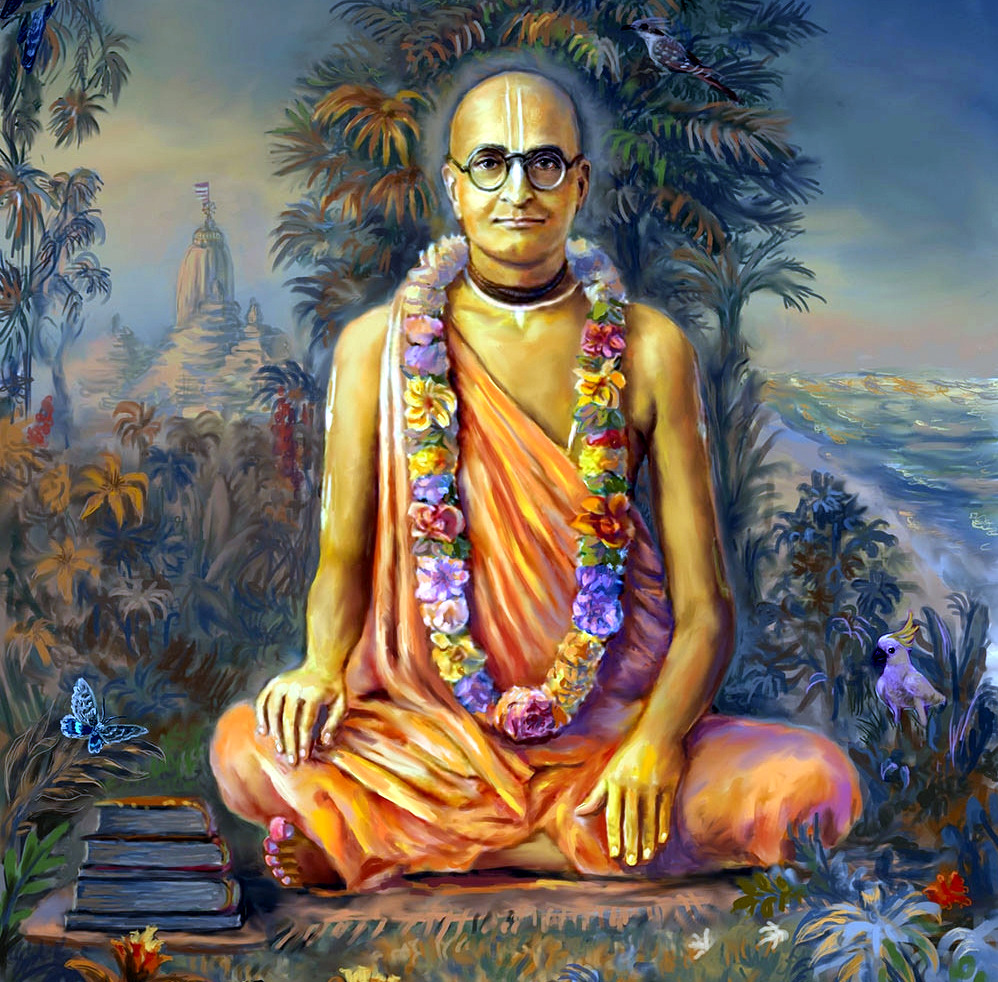
The greatest hero of the conference
Establishing the Authenticity of the Gaura Mantra in 1911
In that same year, at a meeting attended by many devotees and scholars of religion, Srila Bhaktisiddhanta Sarasvati established the truth that the Gaura Mantra is eternal and should be chanted by all devotees. There were claims that the name Gaura in the Gayatri mantra chanted by Gaudiya Vaisnavas was not an eternal name of Godhead. There were also claims that Lord Chaitanya’s Holy Names were not found in the original Vedas, and that Lord Chaitanya was not an incarnation of Godhead, but rather, by His own admission, a devotee of God. Although it is clearly established in the pages of Caitanya-bhagavata and Caitanya-caritamrta that Lord Chaitanya is the Supreme Personality of Godhead Himself, there were some persons who did not believe that His position as an Avatara was revealed in the original Vedas.
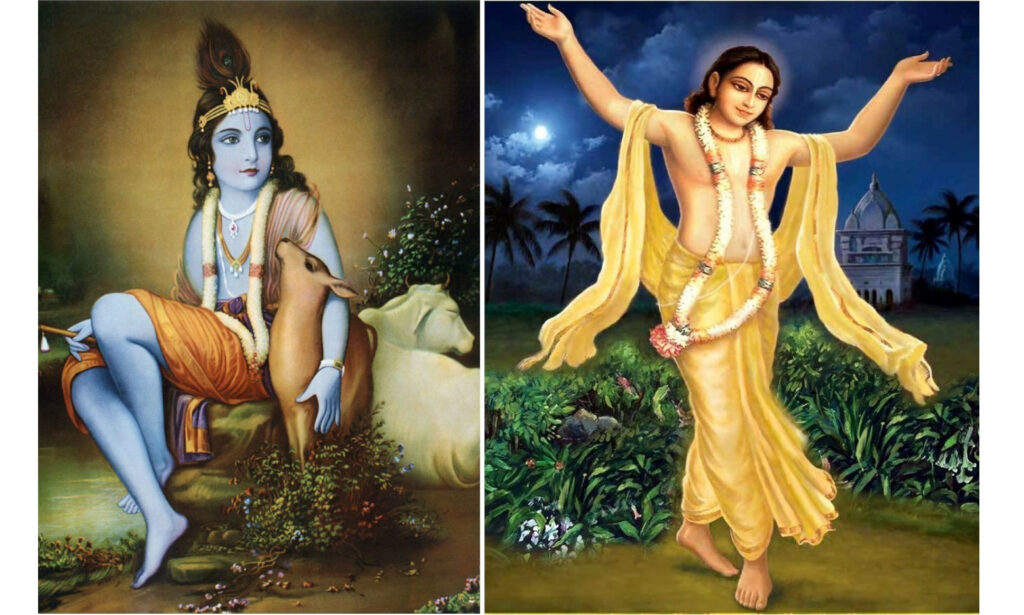
Lord Chaitanya is Krishna playing the role of His own most perfect devotee
Srila Bhaktisiddhanta Sarasvati based his conclusions on the evidence of many scriptures, such as the Chaitanyopanisad from the Atharva Veda, as well as other Upanisads and Puranas. Thus he crushed the theory that the name Gaura is not an eternal name of the Supreme Lord, and that Sri Chaitanya Mahaprabhu was not an incarnation of the Supreme Lord. Srila Bhaktisiddhanta Sarasvati was not aware that his Gurudeva, Srila Gaurakisora Das Babaji, was also present in the audience and greatly pleased to hear his conclusions.
sa hovaca: rahasyam te vadisyami, jahnavi-tire navadvipe
golokakhye dhamni govindo dvibhujo gaurah sarvatma
maha-puruso mahatma maha-yogi trigunatitah sattva-rupo
bhaktim loke kasyatiti. Tad ete sloka bhavanti
Brahma said: “I shall tell thee a secret! On the bank of the Jahnavi [Ganges], at Navadvipa, which is called Goloka Dhama, shall Govinda, in a two armed form, as Gaura, the Great One, the Great Mystic, Who is transcendental to the three modes of material nature, and Whose form is eternal, reveal Bhakti to the world! There are a number of verses in that regard.”
[Caitanyopanisad Text 5 from the Atharva Veda]
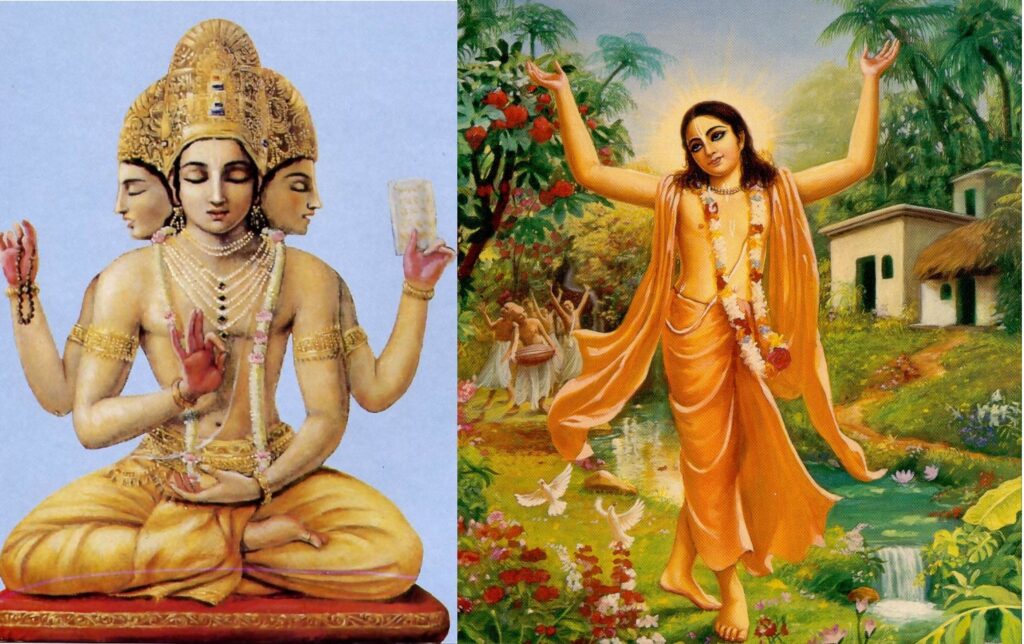
To show mercy to the people and give them devotional service, the Supreme Personality of Godhead will appear in a brahmana’s home in Navadvipa by the Ganges’ shore. The Supreme Person, Sri Krishna Himself, who is the life of Srimati Radharani, and is the Lord of the universe in creation, maintenance, and annihilation, appears as Gaura, O Mahesvari.
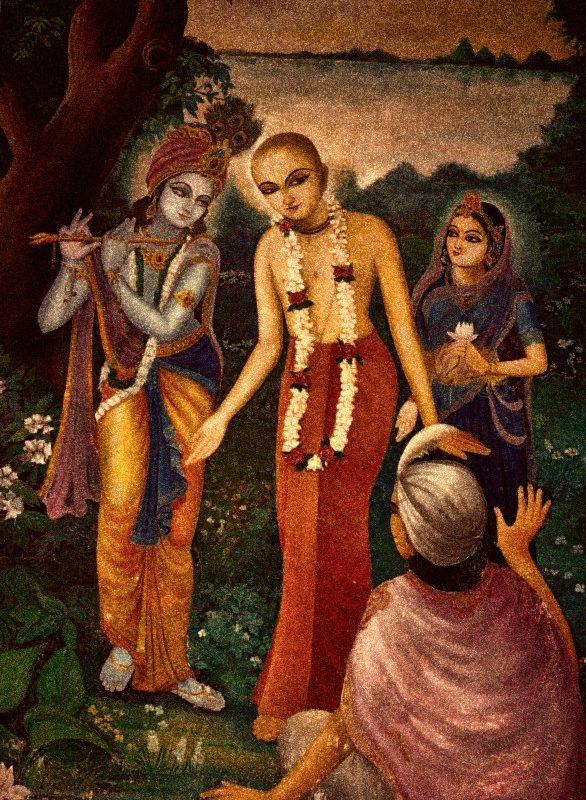
In Kali-yuga, I will descend to the earth with My associates. In Navadvipa, which is surrounded by the Ganges, I will take birth in Sachi devi’s womb. They who are bewildered by My illusory potency will not understand the great secret of the appearance in this world of Me in My personal form, in My form as the incarnation of devotion, in My form as the incarnation of a devotee, in My form bearing the name of a devotee, in My form as a devotee, and in My form as the giver of devotional service. This secret is not to be revealed to them. Only the saintly, pure, renounced devotees, diligently engaged in My devotional service, will be able to understand Me in these five forms [pancha-tattva].
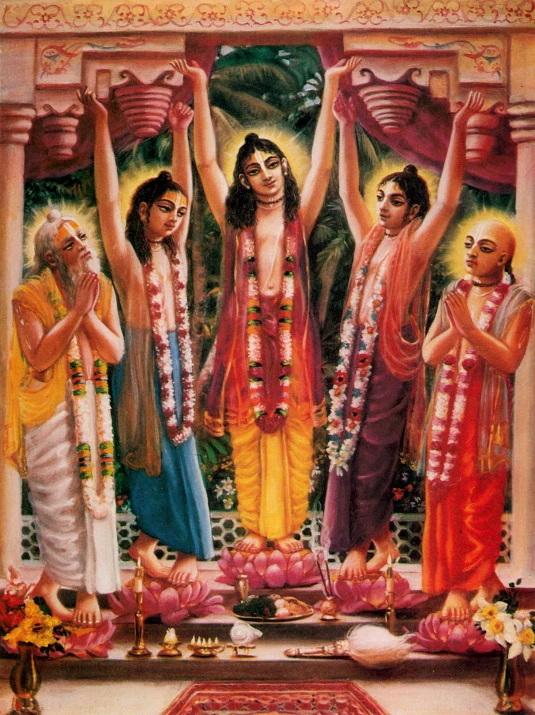
My dear male and female associates, headed by Sridama and Subala, who came to this world at the time of My advent as Lord Krishna, will come again during the Kali-yuga. The gopas will become the sixty-four mahantas and the twelve gopalas. To establish the truth of religion, I will enjoy many pastimes with them. In this way I will again reveal the path of devotional service, which has been destroyed in the course of time. My sons should also descend to the earth, assume the forms of devotees, and, by My order, also work to re-establish the principles of true religion. At this time My names will be: Krishna Chaitanya, Gauranga, Gaurachandra, Sachisuta, Mahaprabhu, Gaura and Gaurahari. Chanting these names will bring devotion to Me.
[Ananta Samhita]
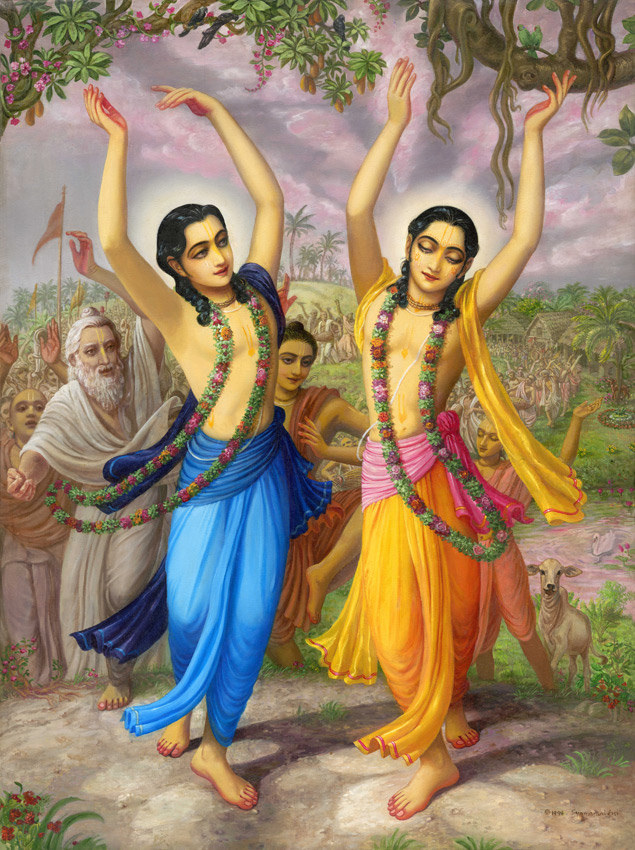
Due, in large measure, to Bhaktisiddhanta Sarasvati’s strong preaching on this point throughout his life, the Deity form of Sri Chaitanya Mahaprabhu is now worshipped and accepted all over India as the eternal form of the Lord, and many thousands have received the Gaura mantra with great faith and for eternal benefit.
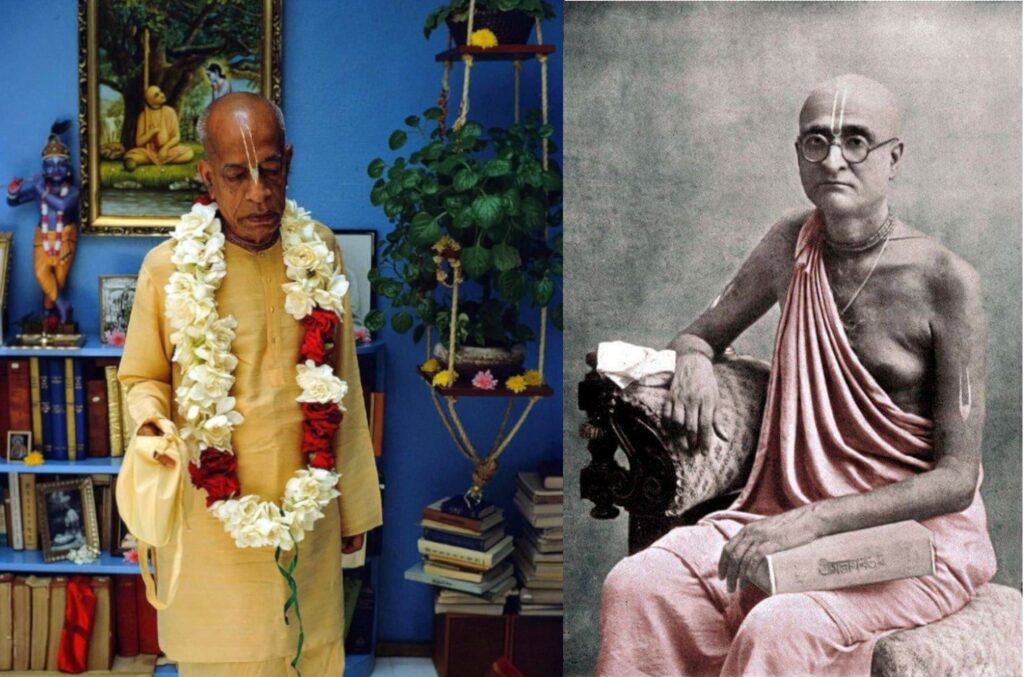
His Divine Grace A.C. Bhaktivedanta Swami Prabhupad commented on Srila Bhaktisiddhanta Sarasvati’s strong preaching against the caste Gosvamis and Smarta brahmans:
My Guru Maharaja’s contribution is that he defeated the caste Gosvamis. He defeated this brahmanism. He did it the same way as Chaitanya Mahaprabhu did. As Chaitanya Mahaprabhu said:
kiba vipra, kiba nyasi, sudra kene naya, yei krishna tattva-vetta, sei ‘guru’ haya:
“There is no consideration whether one is a sannyasi, a brahmana, a sudra, or a grhastha. No. Anyone who knows the science of Krishna, he is all right, he is Gosvami and he is brahman.”
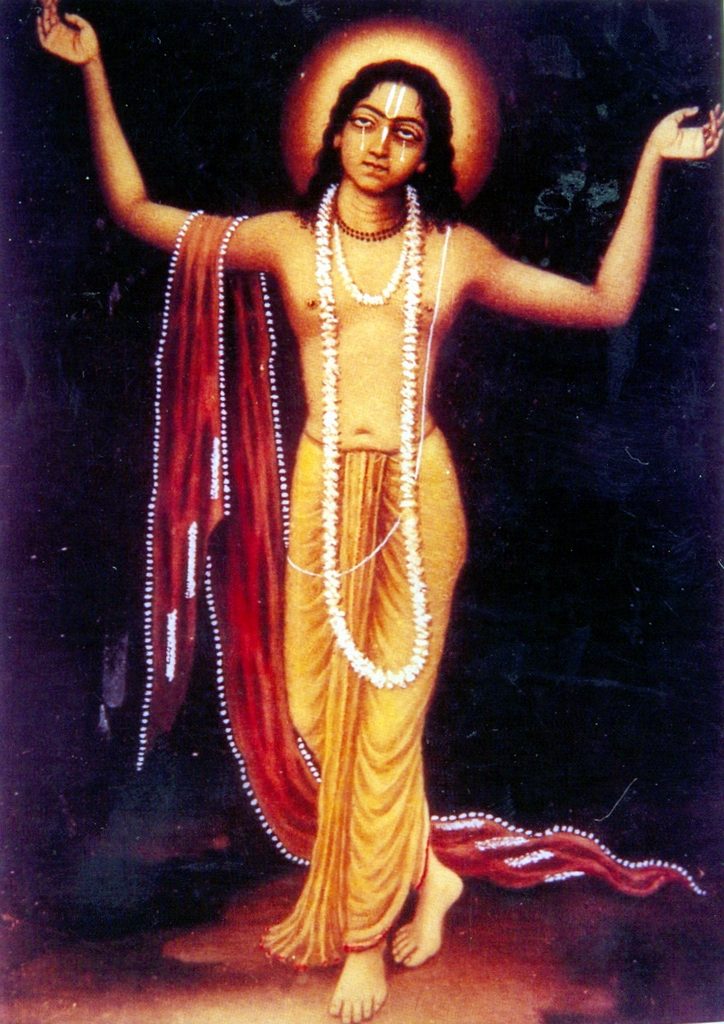
This was my Guru Maharaja’s contribution. And for this reason, he had to face so many vehement protests from these brahmans of the caste Gosvamis. Once they conspired to kill him – my Guru Maharaja told me personally. By his grace, when we used to meet alone he used to talk about so many things. He was so kind that he used to talk with me, and he personally told me that these people, “They wanted to kill me.”
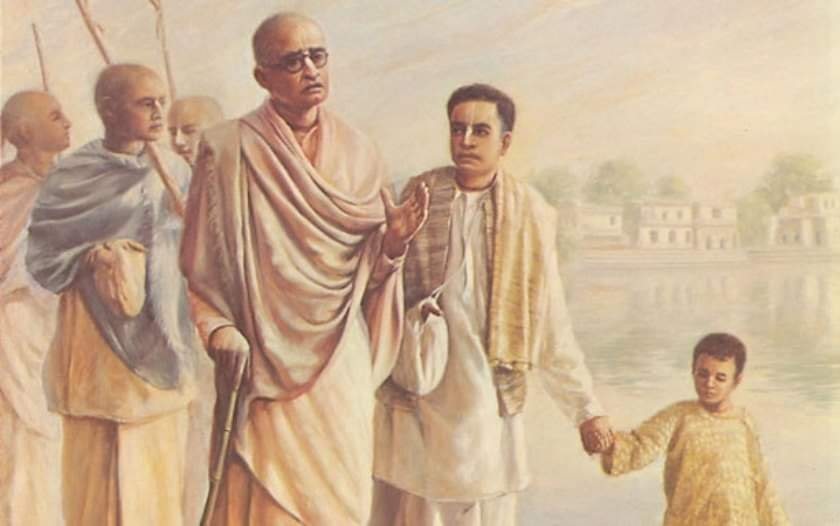
They collected twenty-five thousand rupees and went to bribe the police officer in charge of the area, saying, “You take these twenty-five thousand rupees. We shall do something against Bhaktisiddhanta Sarasvati, and you don’t take any steps.” He could understand that they wanted to kill him. So the police officer frankly came to Bhaktisiddhanta Sarasvati: “Of course, we accept bribes, and we indulge in such things, but not for a sadhu, not for a saintly person. I cannot dare.” So, the police officer refused and said to my Guru Maharaja, “You take care. This is the position.” This was because he so vehemently protested.
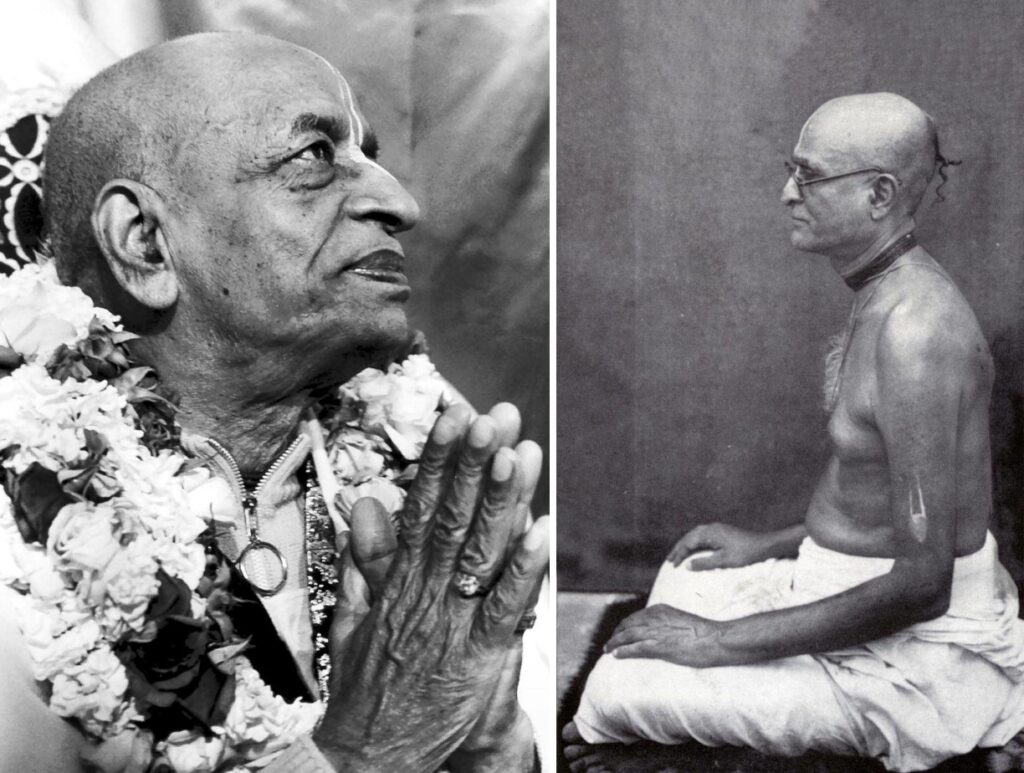
When my Guru Maharaja was present, even big, big scholars were afraid to talk with even his beginning students. My Guru Maharaja was called “living encyclopedia.” He could talk with anyone on any subject, he was so learned. And no compromise. So-called saints, avatars, yogis – everyone who was false was an enemy to my Guru Maharaja. He never compromised. Some Godbrothers complained that this preaching was a “chopping technique” and it would not be successful. But those who criticized him fell down.
The Kasim (Cossim) Bazar Religious Conference of 1912
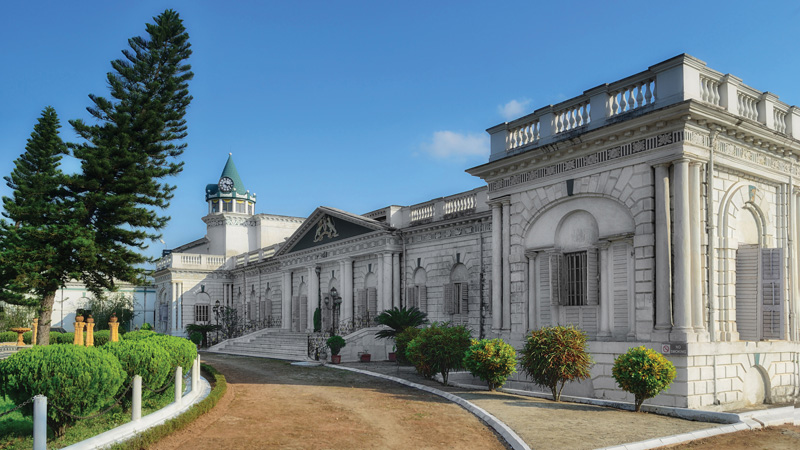
Kasim Bazar Palace
In March 1912, Srila Bhaktisiddhanta Sarasvati was invited by Sri Manindra Chandra Nandi, the Maharaja of Kasim Bazar in Calcutta, to present Krishna bhakti philosophy at the Kasim Bazar Sammilani, an annual religious conference. But when Srila Sarasvati Thakur arrived there, he saw that the organizers were more interested in their mundane concept of religiosity and in pleasing other people than in promoting the concept of pure devotion. To protest these concepts, which were contradictory to pure devotion, Srila Bhaktisiddhanta Sarasvati fasted during his entire stay there and accepted prasadam (food that has been offered to the Supreme Lord) only after his return to Sri Mayapur Dham.
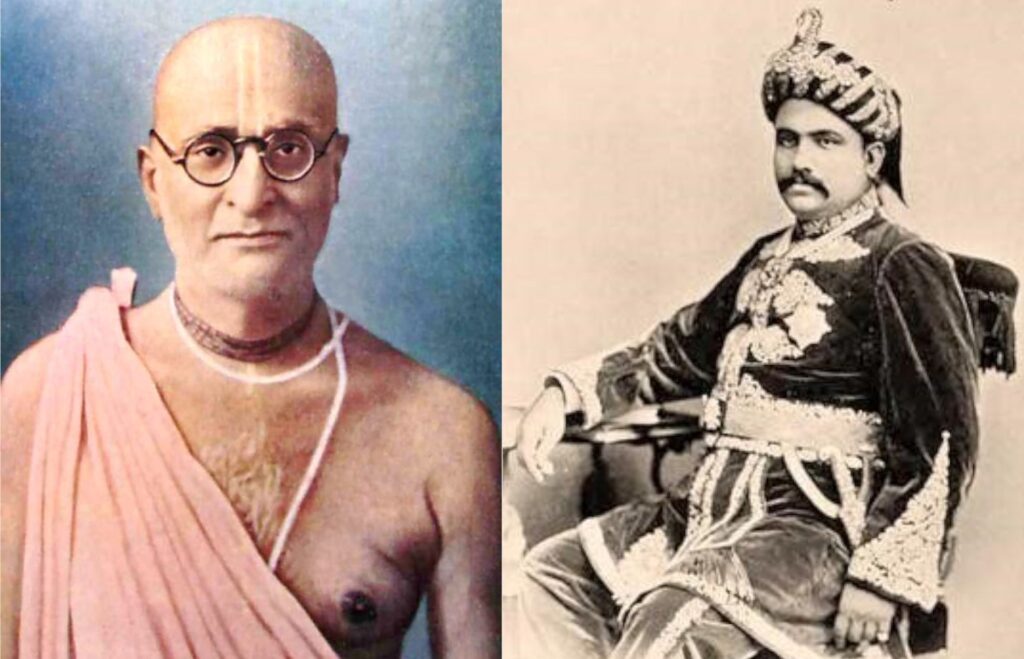
Srila Bhaktisiddhanta Sarasvati and Sri Manindra Chandra Nandi
Pilgrimage and Preaching 1912
In November of 1912, Srila Bhaktisiddhanta Sarasvati set out to visit the holy places where Sriman Mahaprabhu and his associates had their pastimes in the company of a few devotees. They visited Srikhanda, Yajigram, Katwa, Jhamatpur, Chakhandi, Daihat, and other holy places, and preached about pure devotion there. In Sridham Mayapur and the surrounding areas, and sometimes in other villages of Bengal and in Calcutta, he constantly preached and answered spiritual questions.
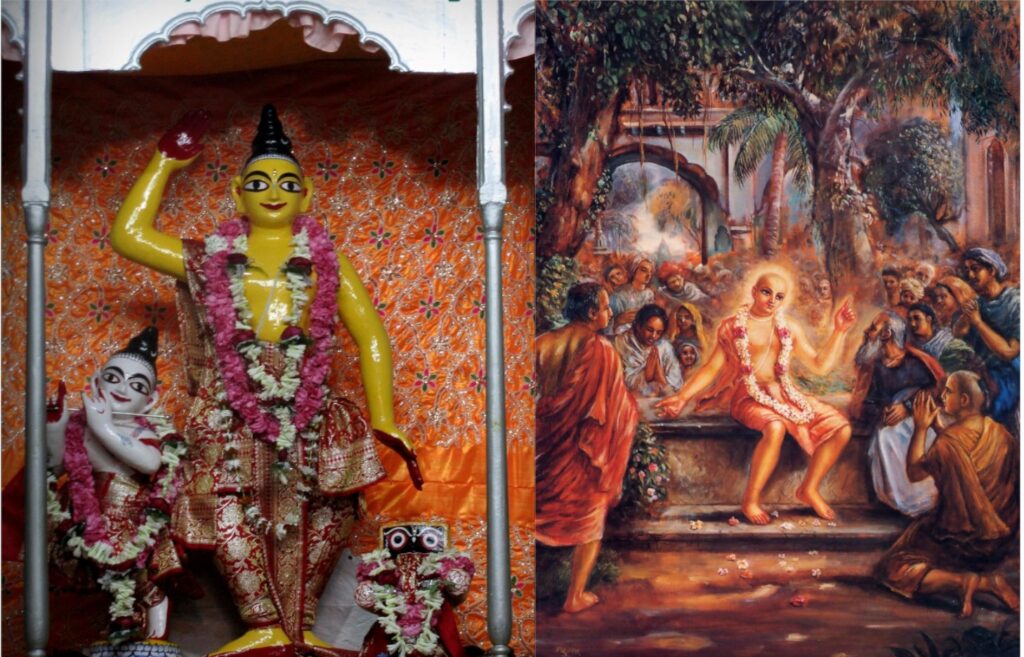
Sri Gauranga Bari Temple at Katwa is on the actual site where Lord Chaitanya took sannyas in 1510 AD. Showing Deities of Lord Gauranga, Lord Nityananda and Lord Jagannath
The Printing Press and the Anubhasya, 1913-1915
In 1913, Srila Bhaktisiddhanta Sarasvati established a press called Bhagavat Yantralaya at Kalighat in Calcutta. He began publishing and printing many books including Sri Chaitanya-charitamrta with his commentaries called Anubhasya, Srimad Bhagavad-gita with the commentaries of Srila Visvanatha Chakravarti Thakur, the Gaurakrsnodaya by the Oriyan poet Govinda Das, and other important Vaisnava literatures. In the evenings he would lead sankirtanand afterwards deliver talks on Vaisnava philosophy. Many distinguished gentlemen of Calcutta would come to listen to him with great appreciation for his scholarship and devotion.
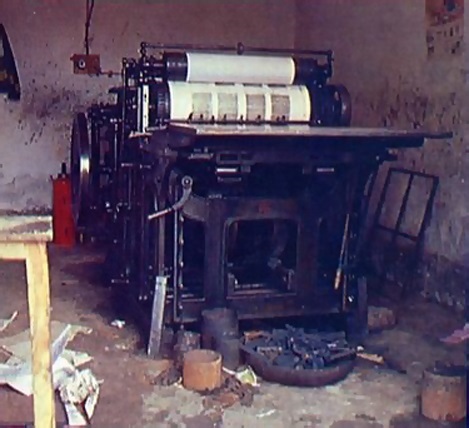
Srila Bhaktisiddhanta Sarasvati used to say that the printing press was the “brihad mridanga” – the big mridanga [drum]. The press pictured above was not Srila Bhaktisiddhanta’s, but was the press on which Srila Bhaktivedanta Swami’s first Bhagavatams were printed in Delhi.
The Disappearance of Srila Bhaktivinoda Thakur
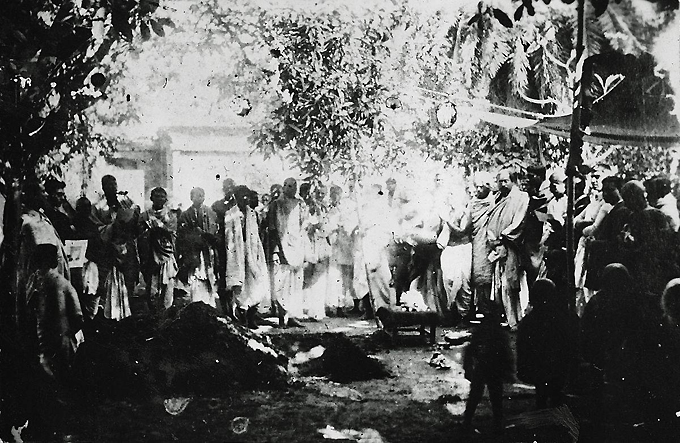
The samadhi ceremony of Srila Bhaktivinoda Thakur
In 1914 Srila Bhaktivinoda Thakur disappeared from this world to enter into the transcendental abode and the Lord’s eternal pastimes. In January 1915, Srila Bhaktisiddhanta Sarasvati moved the printing press to Sri Vrajapattan at Mayapura, and continued publishing and printing books from there. He finished his commentaries on Sri Chaitanya-charitamrta on June 14, 1915. After the disappearance of Srila Bhaktivinoda Thakur, his famous and widely distributed Vaisnava magazine, Sajjana Tosani, continued publication under the editorship of Srila Sarasvati Thakur. In July 1915 he moved the Bhagavat Yantra press to the town of Krsnanagar, and began publishing many of Srila Bhaktivinoda Thakur’s books which had been left unpublished.
The Disappearance of Gaurakisora Das Babaji
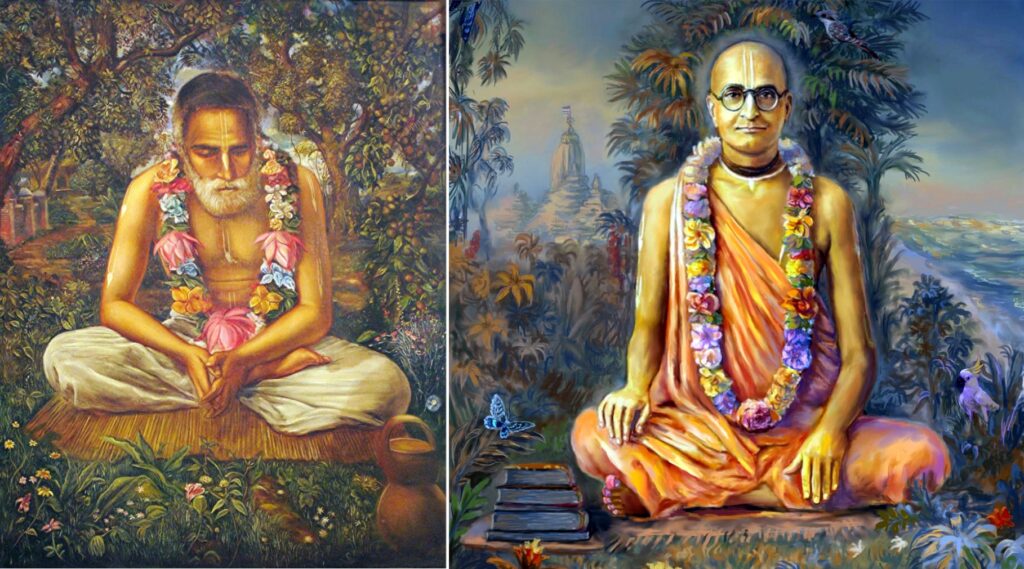
On November 17, 1915, Srila Bhaktisiddhanta’s diksa [initiating] guru, Srila Gaurakisora Das Babaji Maharaj, disappeared from this world. Srila Sarasvati Thakur immediately set forth for Navadvipa from Mayapur. When he arrived, a number of so-called babajis of Navadvipa were arguing with each other about who would give samadhi to the transcendental body of Srila Gaurakisora Das Babaji. They all had some ulterior motive, namely to own this samadhi temple themselves so they could make money in the future by attracting devotees and pilgrims to their asrams and temples. Fearing a breach of the peace, the Inspector of Police arrived there. After much argument, these babajis said that Srila Bhaktisiddhanta Sarasvati was not a sannyasi and therefore did not have the right to give samadhi to Srila Gaurakisora Das Babaji Maharaj.
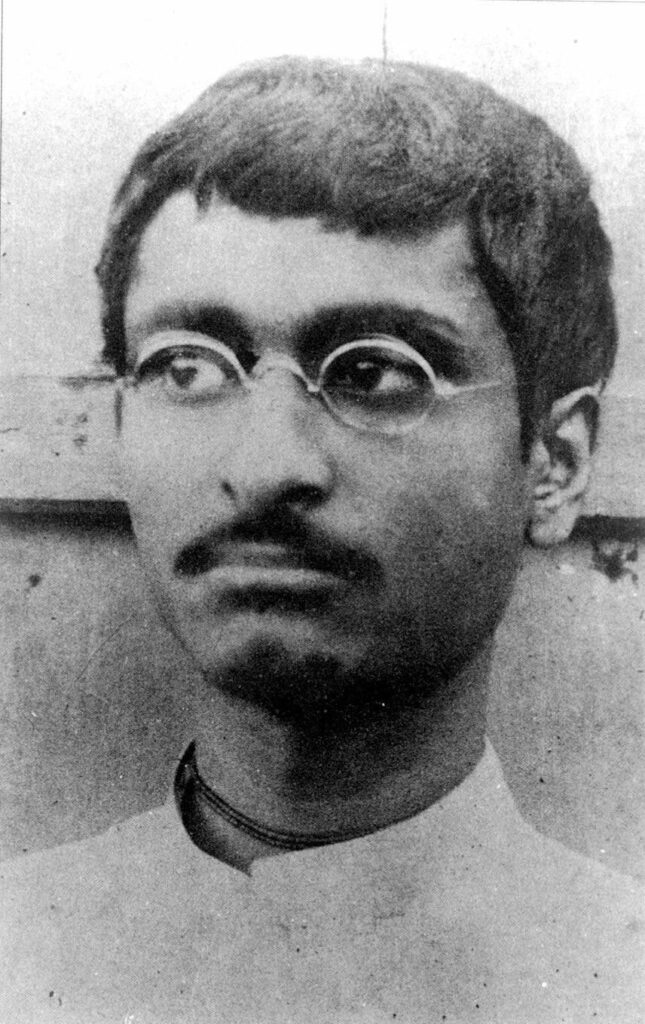
Srila Bhaktisiddhanta Sarasvati responded in a thunderous voice:
I am the only disciple of Srila Babaji Maharaja. Although I am not a sannyasi, I have observed brahmacharya (celibacy) all my life. By the grace of Srila Babaji Maharaj, I have not lived a secret life of illicit conduct and debauchery, like some “monkey” renunciates. If there is someone among those present here who has a genuinely pure character and who is a renunciate, then he can give samadhi to Srila Babaji Maharaj and we have no objection to that. If there is anyone here who, in the last one year, or six months, or three months, or one month, or even in the last three days, did not have any illicit contact with a woman, then he can touch this blissful transcendental body. If anyone else touches this body, he will be ruined.
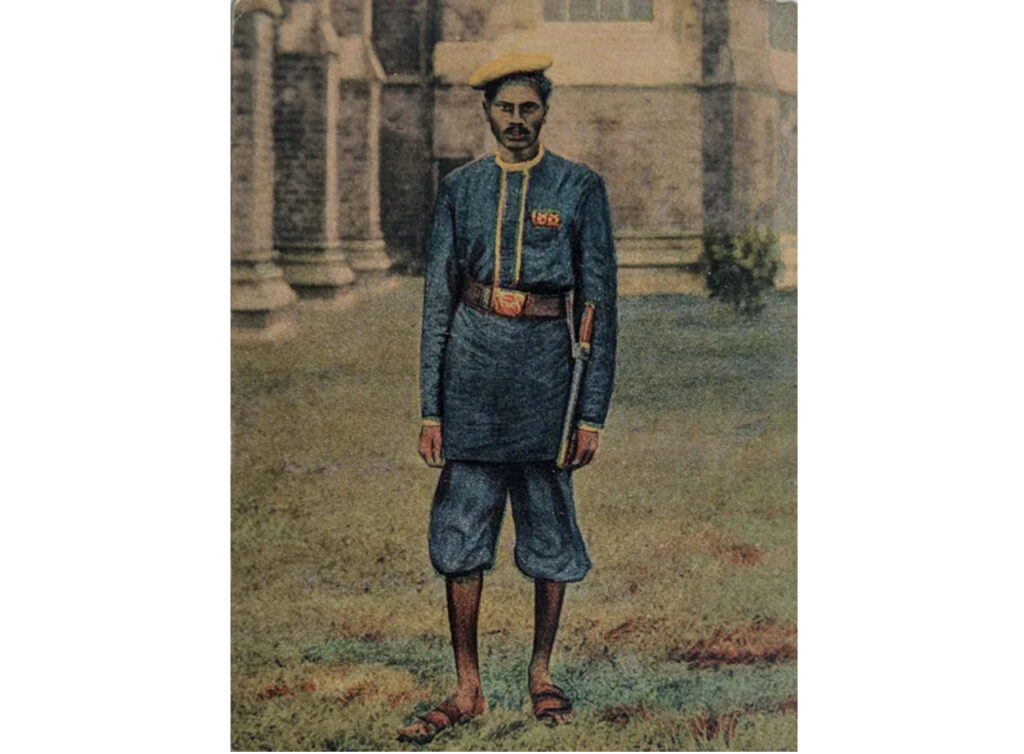
Hearing this, the Inspector asked, “What will be the proof of this?” Srila Bhaktisiddhanta Sarasvati replied, “I will believe their words.” Everyone present was amazed to see that all the so-called babajis left the scene, one by one. The Inspector of Police was dumbfounded. Then, by the order of Srila Bhaktisiddhanta Sarasvati, the Vaisnava devotees with him were fortunate enough to carry the transcendental body of Srila Gaurakisora Das Babaji Maharaj. Some people said, “When Srila Babaji Maharaja was alive, he said, ‘My body should be dragged on the ground of Navadvipa so it can be covered by the dust of Navadvipa.’ His instruction should be obeyed.”
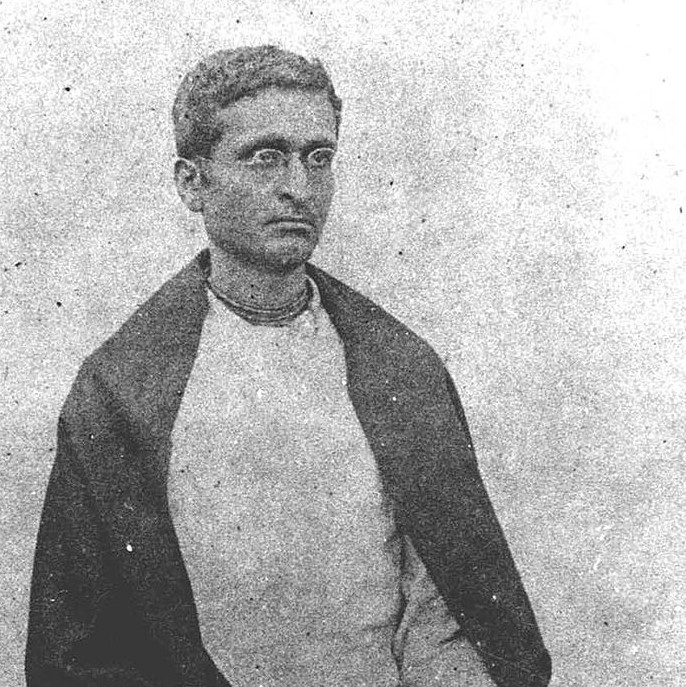
Then Srila Bhaktisiddhanta Sarasvati said:
Even though we are stupid, ignorant, and offensive, we should still be able to understand the significance of these humble words of my Gurudeva, which were spoken to destroy the pride and arrogance of materialistic people. Even Lord Krishna considers Himself fortunate to carry the body of my gurudeva on His shoulders or head. After the disappearance of Srila Haridas Thakur, Sri Gaursundar took his blissful body in his own arms and danced; such was the reverence he showed him. Therefore, following in the footsteps of Sriman Mahaprabhu, we shall also carry Srila Babaji Maharaj’s blissful body on our heads.
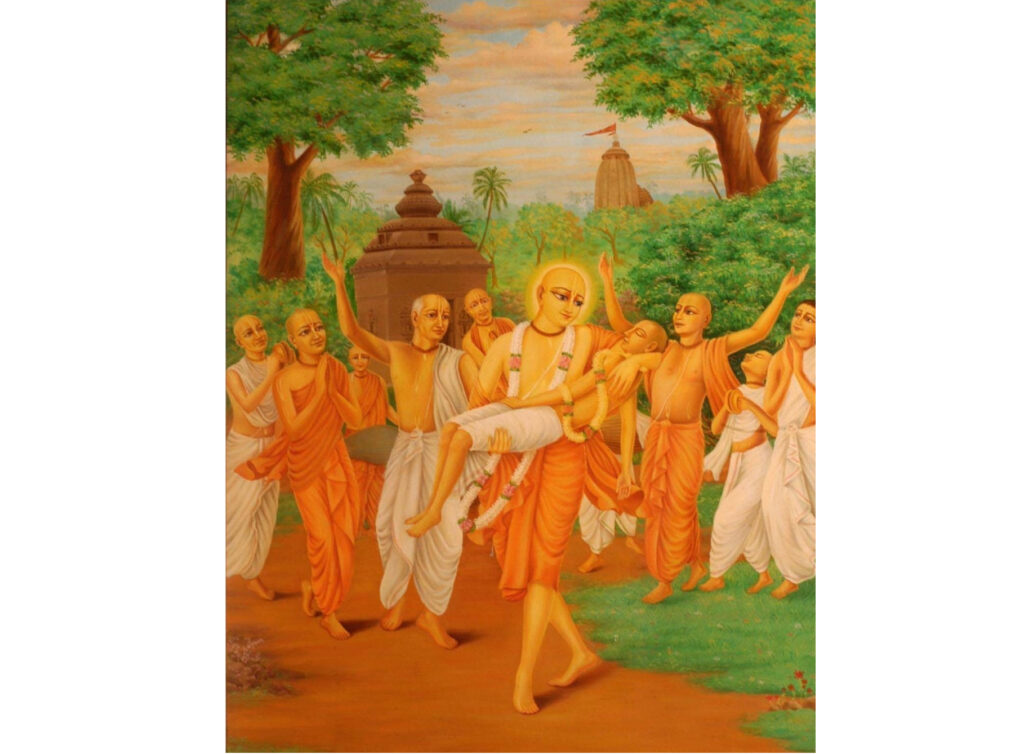
On November 17, 1915, Srila Bhaktisiddhanta Sarasvati gave samadhi to his Gurudeva, on the Nutan Chara of Navadvipa, on the banks of the Ganga. Sixteen years later, the moving currents of the Ganga arrived at that holy place. By his instruction, on August 21, 1932, some of Sarasvati Thakur’s disciples removed Srila Gaurakisora’s holy remains by boat across the Ganga from Navadvipa to the Sri Chaitanya Math in Mayapur.
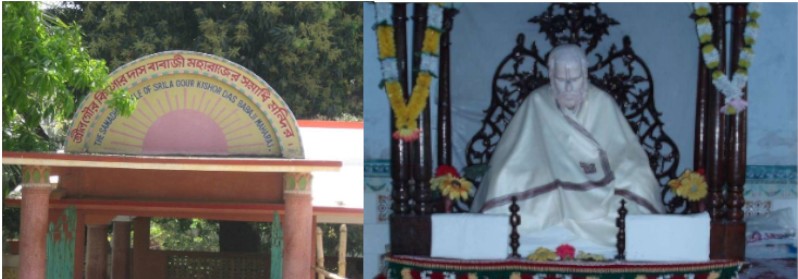
The Samadhi Tomb of Srila Gaurakisora Das Babaji
Srila Bhaktisiddhanta Sarasvati Thakur’s Divine Vision, 1915
After the disappearance of Srila Bhaktivinoda Thakur and Srila Gaurakisora Das Babaji Maharaj, Srila Bhaktisiddhanta Sarasvati was grief stricken and was feeling the pangs of separation. At that time a wonderful incident took place. Srila Paramananda Vidyaratna, a disciple of Srila Sarasvati Thakur, has described this in Saraswati Jayasri:
Srila [Bhaktisiddhanta Sarasvati] Prabhupada was feeling very discouraged in the absence of Srila Thakur Mahasaya and Srila Babaji Maharaja, seeing the helpless condition of the spiritual section in the country and the Propaganda of the sahajiyas (imitators). He was thinking, “How will I fulfill the desire of my spiritual masters? How will I be able to preach the message of Sri Chaitanya Mahaprabhu? I do not have enough money or manpower. Nor do I have any knowledge or talent that would enchant the public. I have no material skill or wealth. How can this grave task be performed by me? I won’t be able to preach the message of my spiritual masters.
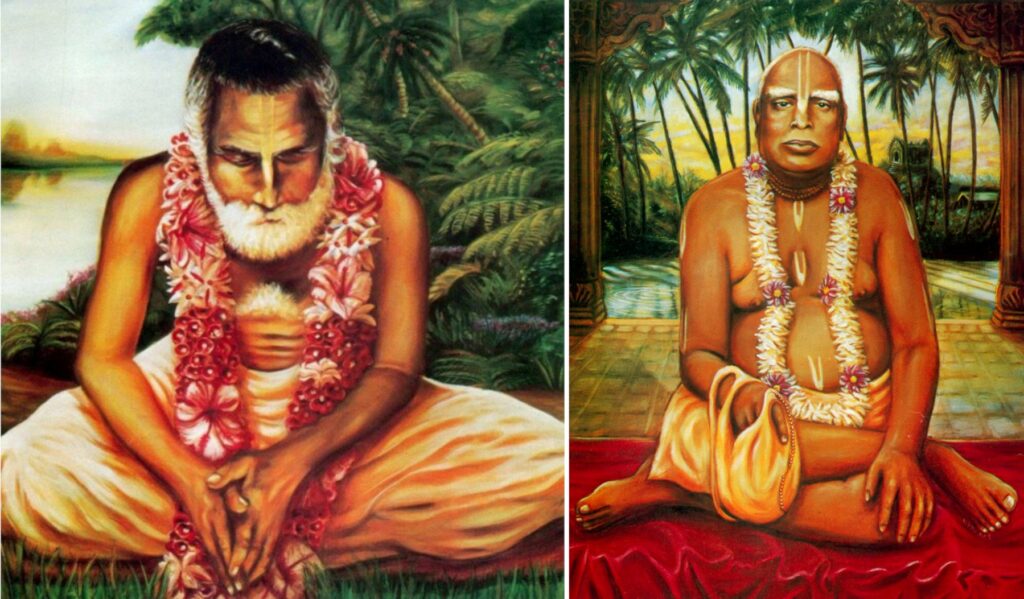
Thinking all this, Srila Prabhupada displayed his pastime of gloom and depression. Then one night he saw in a visionary trance that Lord Gaursundar had arrived from the east side of the Yogapith temple with His associates. Amid the sound of sankirtan, He was ascending to His birth site. With Him were the Six Goswamis. Srila Jagannath Das Babaji, Srila Bhaktivinoda Thakur, and Srila Gaurakisora Das Babaji were also present in their effulgent transcendental forms.
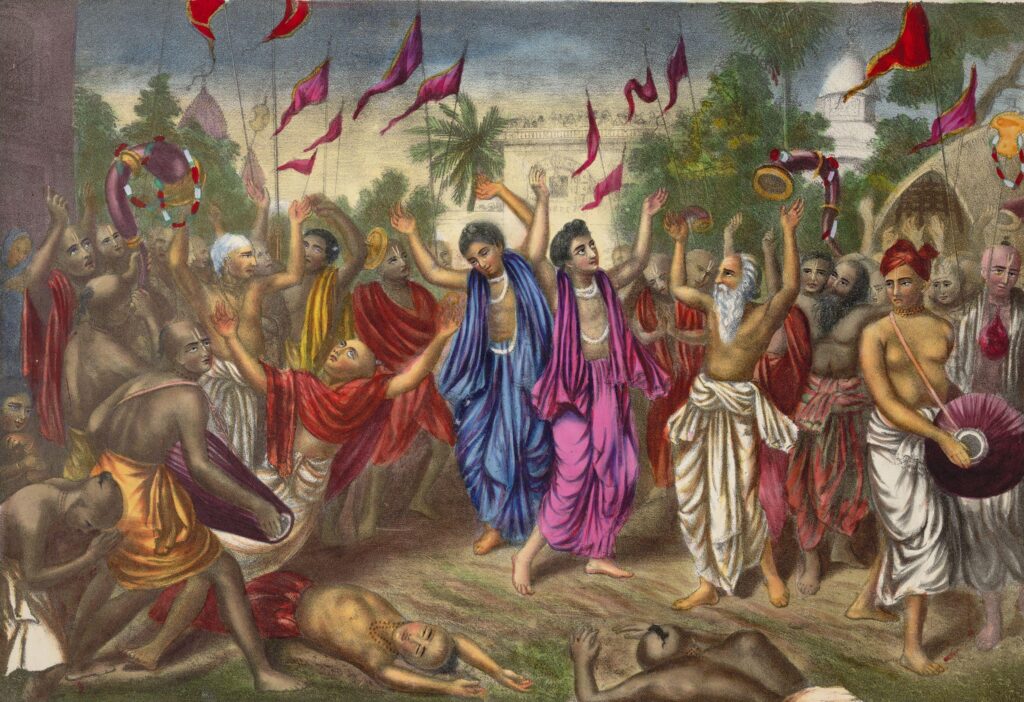
Addressing Srila Prabhupada directly, they said:
“Why are you in such a state of anxiety? Begin your task of establishing pure religion. Everywhere preach the message of Sri Gaura and spread the service of the Holy Name, abode, and desire of Sri Gaura. We are always ready to help you, being eternally present with you. In your mission of establishing pure devotional service, you will always receive our help. Behind you innumerable people, unlimited wealth, and extraordinary scholarship are waiting to help you. Whatever you need at any time will immediately appear to serve your mission of pure devotion. With full enthusiasm, proceed with your preaching of the message of pure devotion as it was preached by Sriman Mahaprabhu. No material problems can impede you. We are always with you.” The next morning Srila Prabhupada told us about this visionary trance with great ecstasy.

[Excerpts from “Sri Chaitanya: His Life and Associates” by Srila Bhakti Ballabh Tirtha Maharaj and “Ray of Vishnu” by Rupa Vilasa Das]


Comment
Haribol!
Thank you so much for this wonderful read.
All glories to the Vaishnavas!